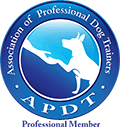
|
Welcome to |
NoseWork... 25 January 2021
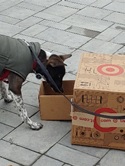 This is Evie learning NoseWork for the first time. Take a closer look at her eyes. She's a little worried about putting her head in the box. Ah, but she gets over it quickly. In no time, she's thrusting herself into all sorts of configurations of boxes to find the hidden treats!
This is Evie learning NoseWork for the first time. Take a closer look at her eyes. She's a little worried about putting her head in the box. Ah, but she gets over it quickly. In no time, she's thrusting herself into all sorts of configurations of boxes to find the hidden treats!
Fear and playfulness cannot coexist in the same individual at the same time. That's why play is such a powerful tool when working with fearful dogs. In contrast, punishment will have detrimental effect when used with a fearful individual. Consider a dog fearful and reactive at the sight of other dogs. If leash corrections are used to decrease the dog's reactive display, can you imagine what the dog is experiencing? Not only will she still be feeling the fear that she already had at the sight of dogs -- we have not made that any better -- but now she is experiencing pain or discomfort when she expresses herself, so she is becoming more, not less, anxious in the company of other dogs. Further, if she associates those leash corrections with her handler, likely her most intimate human partner, might it not damage the relationship between the two? So, while we may have reduced her external expression of fear -- the lunging, the barking -- at what cost?
The field of dog training has come a long way over the last 10 to 20 years. While aversive training used to be commonplace, it was thanks to marine animal trainers that we learned a different, science-based positive reinforcement approach. After all, a killer whale will simply swim away from punishment; our dogs have not been so lucky. But now even police departments, once bastions for punishment-based training techniques, are employing play in their training.
Play Skills... 18 January 2021
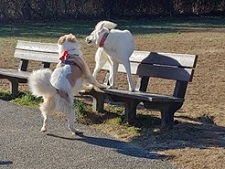 Dogs need to learn skills to deal with social challenges, which is why it's so important for puppies to have play exposure to a variety of playmates and play styles. Tilly (the white shepherd) is incredibly skillful, and she not only comes to a play situation with proven strategies but she also discovers new ones on the fly.
Dogs need to learn skills to deal with social challenges, which is why it's so important for puppies to have play exposure to a variety of playmates and play styles. Tilly (the white shepherd) is incredibly skillful, and she not only comes to a play situation with proven strategies but she also discovers new ones on the fly.
On a recent visit to a dog park, Tilly's playmate was a humper; he looked for any opportunity to sneak up from behind, jump up and get another dog in a clench. Tilly has always been successful at deflecting such advances by whirling around and taking a frontal playbow-like stance that has more to do with readiness to dash away than really being a play invitation. Staying frontal denies such dogs the opportunity to come up from behind.
The disadvantage to Tilly's strategy is that is can be physically taxing. She needs to continue either whirling or sprinting off. On this day, she happened upon another strategy. When she jumped up on the park bench, she discovered that her playmate would not follow her up there. Not only did it give Tilly respite from whirling and dashing but the other dog ultimately lost interest in her and Tilly could go about her business in peace.
Consenting Individuals... 11 January 2021
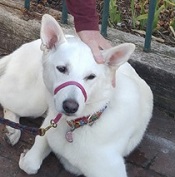 Too often we pet our dogs when we want to touch our dogs, comforted just by the feel of them. And we may continue doing so long after they've had enough. Worse, we allow others to do the same. On the street we might allow passersby to pet our dogs without first consulting with our dogs.
Too often we pet our dogs when we want to touch our dogs, comforted just by the feel of them. And we may continue doing so long after they've had enough. Worse, we allow others to do the same. On the street we might allow passersby to pet our dogs without first consulting with our dogs.
Touching and cuddling should be a mutual experience, a dialogue of consenting individuals; we should ask permission, looking for the answer in the dog's body language and behavior. And once petting, we should be attuned to whether she continues to enjoy the contact or whether enough is enough. One way to do this is to pet for several seconds, then stop and wait to see what the dog does. Does she solicit more, nudging a hand, maybe leaning in? Or does she move away, turn away, even perhaps stay still? An absence of behavior more often means that she's had enough, so staying still may mean that she is enjoying being near you but she may have had enough of the contact.
Thankfully our dogs are so often tolerant, putting up with contact that they would prefer would stop, as Tilly does here. You can see she's more interested in what's happening elsewhere and not asking for or enjoying this contact. Worse, she's in a down-stay so she has no way of removing herself from this situation without disobeying, the very exemplification of being caught between a rock and a hard place. Yet, when dogs get mouthy or nippy in order to warn us away, we say it was "out of the blue". Really, we just weren't listening to their tacit request.
Physical Limitations... 14 December 2020
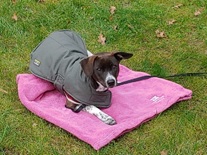
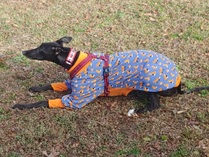 Meet Evie and Rebel. Each is learning the "down" behavior, but with a different backstory...
Meet Evie and Rebel. Each is learning the "down" behavior, but with a different backstory...
Evie was having trouble doing the down initially. It wasn't that she was unwilling but rather that something was making her uncomfortable and she wouldn't go completely belly-to-the-ground. Turns out the grass was too cold for her! As soon as a towel was put down for her, she went down without hesitation. It's not uncommon for smaller dogs to be reticent to go down on cold surfaces, so doing training on a mat or bed might help.
Meanwhile, greyhounds, because of their extremely muscled back legs, have difficulty going into a sit, and Rebel was resistant to being lured to a sit. She was more comfortable going into a down and then being lured into the sit from there. While this might eventually teach her to go directly into a sit, it may also lead to the discovery that the sit is just pretty uncomfortable to her and she'd prefer the down.
So often we label a dog as "stubborn" when we are not considering that there may be a physical limitation that makes a position uncomfortable or even downright painful. Conditions such as arthritis or dysplasia can contribute to a dog's "loss" of training skills.
Eye Contact... 16 November 2020
 Clementine has some soulful eyes, doesn't she?! So expressive! Eye contact is as meaningful with dogs as it is with people. Dogs can give hard eye contact or soft, almond-shaped or round, a direct gaze or averted. And each variation carries important information to the receiver. But what does it all mean? What is Clementine saying?
Clementine has some soulful eyes, doesn't she?! So expressive! Eye contact is as meaningful with dogs as it is with people. Dogs can give hard eye contact or soft, almond-shaped or round, a direct gaze or averted. And each variation carries important information to the receiver. But what does it all mean? What is Clementine saying?
We all know what hard eye contact looks like when another person directs it at us. We say they are shooting daggers at us! Though not easy to describe, it might be said that the outline of the iris is sharply defined rather than diffuse, as it is when the eyes are soft. Sometimes the pupils are dilated, too, showing a state of arousal.
Further, round eyes mean alertness, whether from fear, surprise, or some other usually negative emotion. Dogs have less sclera, or eye whites, than we do, so when a dog's eyes are round, you can see a lot of eye whites, which is termed whale-eye. Whale-eye given as side eye means that a dog is watching you with distrust and warning while stiffly not turning her head. By contrast, when a dog's eyes are squinty and almond-shaped, you won't see eye whites at all, and the muscles of the eye are relaxed and not pulled tight. A dog who offers squinty eyes is giving an appeasing, nonthreatening message.
Finally, direct eye contact can be a very direct message. While dogs are often taught to give eye contact, which is a good way of getting their attention when needed, you should use caution until you know this to be the case. Simply put, if a dog you are unfamiliar with gives you direct eye contact, it is usually a warning and you should take it as such until you know her better.
So, in this pic, Clementine is giving me direct eye contact, leaving no doubt that her message is meant for me. Her eyes are soft (the iris diffuse) and, though not almond-shaped, they are relaxed and showing almost no whites. She is looking beseechingly at me. Yes, she wants my treats!
Bang!... 9 November 2020
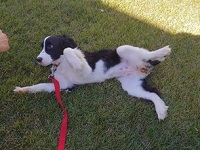 This is Sadie learning "bang!" Like this pup could be any cuter?!
This is Sadie learning "bang!" Like this pup could be any cuter?!
I include tricks as part of every training protocol. For starters, for large-breed dogs, and particularly for "scary" breeds like pits, rots and sheps, tricks are a great way to make people more comfortable in their presence. Who can be scared of a dog who waves goodbye or plays dead on cue?! Even just a few tricks in a dog's repertoire can help put people at ease.
Further, tricks can affect an emotional shift in a dog through physical means. Should a dog get anxious or upset by something, a trick can be the perfect way to get her mind off it and onto something else, something much more fun!
In the case of the "bang" behavior, it is also a great "fear-free" veterinary skill. For instance, should a dog need to have an abdominal x-ray, knowing how to play dead like Sadie does can put her in the right position without physical restraint.
And perhaps most importantly, from the behavior modification standpoint, some tricks are a wonderful way of affecting change in problematic behavior.
Oh, just as an aside, as if you needed more convincing, they can be a great source of exercise, both mental and physical!
Adolescence... 11 October 2020
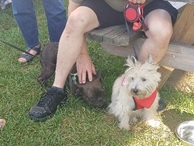
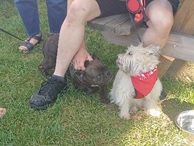 It's easy to think that just because there are no overt signs of aggression that a dog is happy with a situation. Here's an example... One might think that Brady the Westie is fine meeting other dogs and, if fine means no fur is flying, then it's quite true. He is a polite citizen in dog terms. But just because he is ignoring the Frenchy coming up behind him does not mean that he doesn't know he's there... his ears say otherwise. In fact, that he's studiously ignoring that dog while his ears are back and listening means he's doing everything he can to say he's just not into it and would like to be left alone. The Frenchy is not taking the hint and continues to get closer for a sniff. By the second pic, you can see how uncomfortable Brady is -- his eyes rolled back showing whites, his ears back, and leaning slightly away (toward his left shoulder). Adding further tension to this situation is that Brady is on a flexi-leash in its extended setting, meaning that the leash is taut and pulling on Brady, so he's
also feeling the tension of the leash on his neck. Though he can move away with such a leash, the presence of that tension still adds to Brady's feeling of being cornered. Consummate gentleman that he is, Brady tolerates the whole interaction with no more than an eye roll.
It's easy to think that just because there are no overt signs of aggression that a dog is happy with a situation. Here's an example... One might think that Brady the Westie is fine meeting other dogs and, if fine means no fur is flying, then it's quite true. He is a polite citizen in dog terms. But just because he is ignoring the Frenchy coming up behind him does not mean that he doesn't know he's there... his ears say otherwise. In fact, that he's studiously ignoring that dog while his ears are back and listening means he's doing everything he can to say he's just not into it and would like to be left alone. The Frenchy is not taking the hint and continues to get closer for a sniff. By the second pic, you can see how uncomfortable Brady is -- his eyes rolled back showing whites, his ears back, and leaning slightly away (toward his left shoulder). Adding further tension to this situation is that Brady is on a flexi-leash in its extended setting, meaning that the leash is taut and pulling on Brady, so he's
also feeling the tension of the leash on his neck. Though he can move away with such a leash, the presence of that tension still adds to Brady's feeling of being cornered. Consummate gentleman that he is, Brady tolerates the whole interaction with no more than an eye roll.
Too often we put our dogs into situations in which they're uncomfortable and we expect them to respond without protest. But dog body language is just that -- a language, and we must be attune to the messages that they are sending with every movement and gesture. Otherwise the dialogues they are inviting us to join will be reduced to crude jumbles of missed signals interrupted by seemingly "out of the blue" protests.
Adolescence... 28 September 2020
 Not too long ago, this was beyond imagination! Jersey, the little pup in front, is a COVID quarantine victim, and his lack of socialization during those early months left him terrified of other dogs. His mom has worked tirelessly with him and it's made all the difference in the world! This involved slowly and patiently exposing him to other dogs, starting with laidback pooches (like Boomer, the beagle on the right) and gradually widening the net to include more challenging partners (like big boy Gonzo on the left). In so doing, he is learning to better understand the body language of his playmates. Because, while before, everything dogs did seemed threatening to Jersey, now he is starting to recognize what play behaviors look like.
Not too long ago, this was beyond imagination! Jersey, the little pup in front, is a COVID quarantine victim, and his lack of socialization during those early months left him terrified of other dogs. His mom has worked tirelessly with him and it's made all the difference in the world! This involved slowly and patiently exposing him to other dogs, starting with laidback pooches (like Boomer, the beagle on the right) and gradually widening the net to include more challenging partners (like big boy Gonzo on the left). In so doing, he is learning to better understand the body language of his playmates. Because, while before, everything dogs did seemed threatening to Jersey, now he is starting to recognize what play behaviors look like.
Though the most formative time for a puppy is the first four months of his life, called the sensitivity period, the months of adolescence that follow are also an important time of learning, whether it's continuing that early education or making up for a lack of one. Social maturity can start somewhere around 18 months and extend up until three or four years. With social maturity, behavior changes and solidifies, and particularly so around other dogs. A socially mature dog will narrow his interests in other dogs, liking some and disliking others, for no apparent reason. Further, aggressive displays from a socially mature dog can start to have more serious intent. Thus, while an early education is so important, the next best thing is to make up for any lack of it during adolescence, as intervention after social maturity has greater challenges.
An Arranged Marriage... 21 September 2020
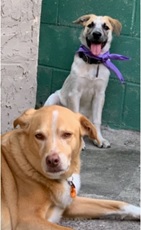 Can you think of a good caption for this picture? Those faces say it all, right?! The word whippersnapper is definitely uttered somewhere in Ollie's expression.
Can you think of a good caption for this picture? Those faces say it all, right?! The word whippersnapper is definitely uttered somewhere in Ollie's expression.
This is the familiar story in many a household. A new pup joins the home, with the hopes of keeping the older dog active, playful and youthful. But the older dog, used to the rhythms and patterns of his former life, may get grouchy and over-corrective with the puppy. And the youngster, who by his very nature is pushing buttons and learning the ropes of appropriate play, may get scared or even physically injured by an intolerant older dog.
It's important to remember that this is like an arranged marriage, one that will take great care and nurturing to develop into a loving relationship. Both dogs will need time away from one other as well as individual time with their humans. The human family should not consider the older dog to be the keeper and babysitter to the new puppy. If the family does not have enough time to train and manage the puppy, then it's not the right time to take on the extra responsibility. Further, the puppy will need plenty of exercise so that he is tired and respectful and NOT pushy or overbearing with his older sibling. And finally, while training is important enough in a single-dog household, it is crucial in a multi-dog household so that expectations for appropriate behavior can be communicated to each member of the family.
Belly Up... 24 August 2020
 One of the most misunderstood signals of dog body language is the "tap out", or passive submission. To be clear, this is not a pic of a tap out. This is Sadie actually requesting a belly rub. In a tap out, which Sadie does frequently when she's uncom-fortable, her head is turned away, her mouth is closed, and her tail is tucked tightly to her belly. This belly rub request is different, right? With the lolling tongue, a happy-faced look as she engages directly with me, and a relaxed tail. So why am I mentioning it then?
One of the most misunderstood signals of dog body language is the "tap out", or passive submission. To be clear, this is not a pic of a tap out. This is Sadie actually requesting a belly rub. In a tap out, which Sadie does frequently when she's uncom-fortable, her head is turned away, her mouth is closed, and her tail is tucked tightly to her belly. This belly rub request is different, right? With the lolling tongue, a happy-faced look as she engages directly with me, and a relaxed tail. So why am I mentioning it then?
The tap out is a signal of a dog's insecurity and an effort to stop another individual's behavior. (For instance, a dog may tap out when we grab the collar or try to put on a harness.) We are often not respectful of this signal, leading to misunderstanding and even to escalated warning. The problem is that, with a dog who uses both tap outs and belly rub requests, it can be confusing to the human reader, and, even if not to the owner, then to others less versed in general dog body language and to the language specific to this dog. Further, a dog like Sadie would benefit from building her confidence, so it would be better to reward her for more confident requests for affection, like "saying please" with a pretty sit, for instance, while also decreasing the situations in which she feels uncomfortable enough to tap out.
The nuances of dog body language are fascinating but can also be challenging. Understanding body language -- not only your dog's body language but also the impact your own has on him -- is an essential component to training, to communication, and to relationship.
Games... 3 August 2020
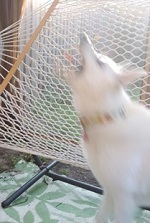 This is Tilly catching a treat, a finely tuned talent of hers. Not only is she good at it but she enjoys it, and she executes her moves with great flourish and efficiency, and with a spark in her eye!
This is Tilly catching a treat, a finely tuned talent of hers. Not only is she good at it but she enjoys it, and she executes her moves with great flourish and efficiency, and with a spark in her eye!
I've been asked many times to train a dog to play fetch so that the dog and her family can share a fun game. Of course dogs can be taught to fetch and some, with time, may enjoy it. In fact, sharing a dog's favorite activity or game can be very bonding indeed, but you will have greater successful choosing something for which your dog has a natural inclination and enjoyment. So, for the natural retriever, a game of fetch will be unparalleled by any other activity. But there are so many other outlets that may better satisfy your dog and build the foundation of the relationship that your desire to have with her.
Some dogs enjoy sniffing, so a game like NoseWork or "go find it" (see this WoofGang article for instructions) might be fun. For dogs who like running and chasing, lure coursing or running beside a jogger or a bicycle might scratch the itch. Athletic dogs who like to run and jump might enjoy adventure coursing, agility or flying disc (frisbee) catching. And for dogs who love the water, swimming or dock diving can make a splash. Of course, you might simply want your dog to fetch for the sake of exercise rather than as a shared, bonding activity. Well, for a dog-friendly dog, dog play may be the perfect outlet. Or, for the dog who's more food- than toy-motivated, you might encourage her to find and "fetch" a tossed treat.
All Smiles... 20 July 2020
 Run for the hills! Ali is showing teeth!
Run for the hills! Ali is showing teeth!
Sorry, just joking... have no worries here. Ali is smiling, or giving what's called a "submissive grin", not baring teeth in a threat display. The submissive grin is a fairly rare dog behavior and only a small percentage of dogs do it (and it can be so fleeting that it's hard to capture in a pic). Those dogs who smile will typically do so at times of excitement, like when meeting someone or when anticipating something uber desirable like going for a walk.
Because it's so rare, and because of its similarity to its more threatening cousin, the dog smile is often mistaken to mean the very opposite of its intention. Interestingly, the submissive grin is an appeasement gesture, the very nature of which is nonthreatening. There are a few key things that will help differentiate the two... firstly, it helps to look at whether the rest of the body is loose and wiggly or whether it's stiff. The ears tend to be softly back and, perhaps most telling, the eyes are soft and squinty rather than hard and dilated. Also, when smiling, the muzzle is pulled back from the teeth rather than pulled tightly up to display the teeth; this can mean that the muzzle is rather smooth instead of being wrinkly and puckered. Still, when in doubt, it's best to ask the owner.
One thing's for sure... when a dog's a smiler and she smiles at you, you feel very special indeed! <3
Consentual... 29 June 2020
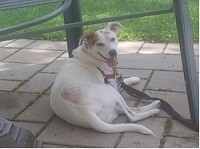 This is Trixie, a foster dog, enjoying a restful moment in the shade on a hot day. She looks relaxed and happy, with her squinty eyes and side-cocked ears. Trixie is a bit shy with new people, so her foster mom wanted to teach Trixie some new skills to help with this as she waits to find for her fur-ever home. You can see that it didn't take her long to get relaxed in my company and she's looking back at me inquiringly, wondering if there are still treats to be earned.
This is Trixie, a foster dog, enjoying a restful moment in the shade on a hot day. She looks relaxed and happy, with her squinty eyes and side-cocked ears. Trixie is a bit shy with new people, so her foster mom wanted to teach Trixie some new skills to help with this as she waits to find for her fur-ever home. You can see that it didn't take her long to get relaxed in my company and she's looking back at me inquiringly, wondering if there are still treats to be earned.
Our interactions with dogs, especially unfamiliar ones, need to be consensual. All too often, we make overtures to dogs that might be appropriate for greeting another human but are not so for greeting a dog. If I wanted to interact with Trixie as she is in this picture, resting under the table, I would invite her to approach me using a high, happy voice and a slap to the thigh in invitation, leaving the approach up to her (thus offering her consent). To reach towards her, bending and looming over her, would corner her and could quite likely make her feel defensive. While many dogs are forgiving of such rude, threatening human behavior, shy dogs are more sensitive to it. The onus is on us humans to be sensitive to the perceptions of our canine companions and fluent in dog body language as they express their needs and preferences to us.
Getting Dogged... 22 June 2020
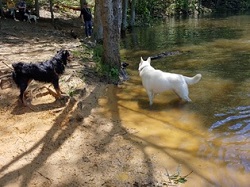 Can you tell which dog is having the problem here? Tilly, the white shepherd, is doing a look-away, with one ear cocked in the direction of the dog who's doggin' her. That dog is standing on the shore, oriented directly at her. The backstory is that, while TIlly likes to be chased, the other dog was too intense a chaser and, as Tilly started to tire and wanted the game to end, she sought refuge in the lake, hoping the other dog wouldn't follow. The look-away is her effort to attract no more of the other dog's attention; she's hoping he'll lose interest in her.
Can you tell which dog is having the problem here? Tilly, the white shepherd, is doing a look-away, with one ear cocked in the direction of the dog who's doggin' her. That dog is standing on the shore, oriented directly at her. The backstory is that, while TIlly likes to be chased, the other dog was too intense a chaser and, as Tilly started to tire and wanted the game to end, she sought refuge in the lake, hoping the other dog wouldn't follow. The look-away is her effort to attract no more of the other dog's attention; she's hoping he'll lose interest in her.
While nothing overt happened here -- there was no growling or snarling -- Tilly could have needed some help, depending on how the play progressed. If the other player had continued to "dog" her and ignore her polite turn-off signals, she might have needed a human to step in and extricate her. Otherwise, she would be forced to "fight her own battles", which could result in injury to either dog. And it would teach her that polite, inhibited signals do not work and that she should be more threatening with pushy dogs in the future. In fact, we should reinforce her polite communications, as it is players like this who keep the peace.
Appropriate Corrections... 17 February 2020
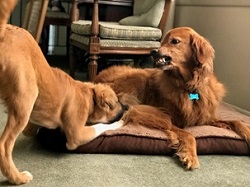 With a snarly face like that, that red dog is a bad one, right?! Actually, no. Zeb is being perfectly appro-priate. He is trying in every way he knows how, without blood-shed, to tell Simon that he's had enough. The problem is that Simon doesn't take "no" for an answer, and Zeb's inhibited warnings do nothing to quell his behavior.
With a snarly face like that, that red dog is a bad one, right?! Actually, no. Zeb is being perfectly appro-priate. He is trying in every way he knows how, without blood-shed, to tell Simon that he's had enough. The problem is that Simon doesn't take "no" for an answer, and Zeb's inhibited warnings do nothing to quell his behavior.
This is a common story in multi-dog families where there is a difference in age, or at least a disparity in activity level. In fact, it is not unusual, in multi-dog families, for the younger dog to have an inappropriate and obnoxious play style, and here's why... Often the family is attentive and thorough about socializing the first dog, but when a puppy is added to the household, it is assumed that socializing the puppy with the older sib will be enough. And if that older dog is tolerant and inhibited and appropriate, as Zeb is being here, and the puppy is not respectful of the warnings, then you've got a little devil in the making! Worse still, this puppy may suffer the consequences of his incomplete education when he finally meets a less patient recipient at the dog run... He can find himself in a heap o' trouble.
Submissive Behavior... 27 January 2020
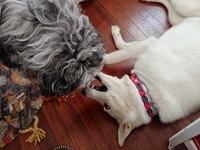 Labeling a dog as dominant or submissive is entirely missing the nuances of relationships between dogs. Instead, calling the behavior as either more dominant or more submissive is more accurate because, rather than labeling a dog with a fixed trait or personality, it recognizes the dynamic nature of relationships.
Labeling a dog as dominant or submissive is entirely missing the nuances of relationships between dogs. Instead, calling the behavior as either more dominant or more submissive is more accurate because, rather than labeling a dog with a fixed trait or personality, it recognizes the dynamic nature of relationships.
Here Tilly is showing the more submissive behavior by playing from her side. But to assume that a dog rolling on her side/back is necessarily expressing submission would also not be accurate. A dog may roll on her back in a "tap out", a way of trying to turn off perceived agonistic behavior of the other. In such a case, this would be an act of submission with a serious communication intent and not a play behavior at all. But back to Tilly… as she pulls this play move, she is self-handicapping for Boomer, a younger, shyer pooch, because she trusts him and because she is helping him gain confidence. So, fascinatingly, the more submissive behavior is clearly not because she is the more "submissive" dog. In fact, she is the more confident and self-assured of the two.
Canine communication are nuanced, complex and dynamic. And it is truly fascinating to watch. And they use these same means of expression and communication with us as well.
The Secret to Good Play... 20 January 2020
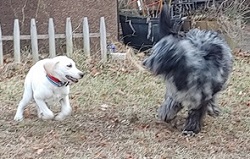 The secret to good play is that it's even but that does not mean identical. Some dogs naturally like to chase; others to be chased. Some like to jump while others are masters at eluding the jumper. So we needn't worry if the roles do not reverse, only that both players are enjoying themselves.
The secret to good play is that it's even but that does not mean identical. Some dogs naturally like to chase; others to be chased. Some like to jump while others are masters at eluding the jumper. So we needn't worry if the roles do not reverse, only that both players are enjoying themselves.
Play is dynamic, not static. So the dog who enjoys being chased might start enjoying it less as he begins to tire or if the chasers start to get frustrated and more intense. One of the easiest indicators to spot of play going bad is when a dog's tail drops. A dog whose tail is aloft as he runs is usually comfortable and enjoying himself. But if you see his tail drop down or tuck as he runs, his feelings have changed and it's time to offer assistance.
The old approach of letting dogs sort things out for themselves is long past. This is only inviting fights to erupt. If a dog is showing inhibited signals that he's had enough of another dog's playstyle and the receiver dog is not respecting the message, allowing the interaction to continue is only forcing the dog to take a more aggressive stance, and that's how fights start.
Leash Manners... 13 January 2020
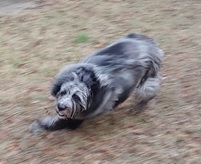 Boomer is a total love off leash with other dogs... but not so much on leash. He can be intense and reactive. This dichotomy is not at all unusual.
Boomer is a total love off leash with other dogs... but not so much on leash. He can be intense and reactive. This dichotomy is not at all unusual.
A dog-friendly dog on leash can get frustrated when the leash thwarts his ability to approach dogs as he'd like to, and frustration, over time, can morph into something more aggressive. Further, that frustrated behavior can affect the reception he gets from the other dog, starting things off on the wrong paw. After all, the presence of leashes is changing the body language of both dogs, which can lead to misunderstandings. And a dog who is socially insecure may act defensively because he knows he does not have the autonomy to approach or move away from the other dog as he might want; thus he preemptively warns them off with an ugly display.
We often blame ourselves for our dogs' bad behavior, especially if he's his worst when walked by one particular handler. This might actually have more to do with the strength of his relationship with that person than their handling abilities. After all, if he has his "peeps" to back him up, he might be more apt to pick a fight than if he's without them, right!?
Whatever the reason for your dog's leash reactivity, it's worth helping him be a polite citizen on leash. After all, his behavior is also affecting the dogs who are incurring his wrath.
Play Mates... 30 December 2019
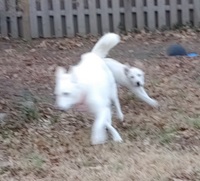 Tilly is entertaining a visitor... Solis, the lab puppy! And with a puppy, it takes a village! There's a LOT to learn in a short amount of time... exercise, mental stimulation, socialization, chew and bite inhibition, restraint and handling tolerance, resource guarding prevention, house-, crate- and aloneness training. So, having a dog like Tilly who's a good dog player with puppies -- at least for the exercise part of the work -- can be a big help! And, while Tilly was initially a socialization opportunity for Solis, as they became familiar with each other, it was more an exercise in developing a respectful relationship than in socialization. Patterns can develop in play which may be a good or bad lesson for a puppy to learn. In Tilly's and Solis' case, Tilly is not a good enough limit-setter to teach Solis the bounds of respectful play and the danger, then, is that Solis will learn to approach other play partners with a pushy play style. What she needs is a good snarking!
Tilly is entertaining a visitor... Solis, the lab puppy! And with a puppy, it takes a village! There's a LOT to learn in a short amount of time... exercise, mental stimulation, socialization, chew and bite inhibition, restraint and handling tolerance, resource guarding prevention, house-, crate- and aloneness training. So, having a dog like Tilly who's a good dog player with puppies -- at least for the exercise part of the work -- can be a big help! And, while Tilly was initially a socialization opportunity for Solis, as they became familiar with each other, it was more an exercise in developing a respectful relationship than in socialization. Patterns can develop in play which may be a good or bad lesson for a puppy to learn. In Tilly's and Solis' case, Tilly is not a good enough limit-setter to teach Solis the bounds of respectful play and the danger, then, is that Solis will learn to approach other play partners with a pushy play style. What she needs is a good snarking!
Though Tilly's patience seems limitless, it's clear as the days go by that she's tiring of the pushy pup. So, while Tilly's help was a boon to me in the beginning, I have had to stop relying on her and instead take responsibility for Solis' exercise needs upon myself. Otherwise I will have a very unhappy canine partner in Tilly.
Relationships are dynamic and ever-changing. What was working well one day may not be the next, and we humans need to actively parent so that each dog is living her best life! If a puppy like Solis were joining our household permanently, this might mean that play dates be arranged with other dogs who could tire her out and give her good corrections so that she would be more tired and respectful around her more sedate housemate, for the ease and happiness of both of them.
Sniffing... 11 November 2019
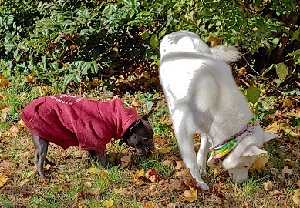 It might not look like a lot is going on here, other than catching up on the neighborhood pmail, but this is actually a very import-ant play behavior. When play ramps up and needs a bit of modulation so that it doesn't get out of control, good dog players will take a break, by sniffing, drinking water, or just generally quietly coexisting for a few moments. Gus the Frenchy had just been chasing madly after Tilly, and Tilly, needing a break, discovered a spot she REALLY wanted to sniff. Gus politely took the hint and followed suit.
It might not look like a lot is going on here, other than catching up on the neighborhood pmail, but this is actually a very import-ant play behavior. When play ramps up and needs a bit of modulation so that it doesn't get out of control, good dog players will take a break, by sniffing, drinking water, or just generally quietly coexisting for a few moments. Gus the Frenchy had just been chasing madly after Tilly, and Tilly, needing a break, discovered a spot she REALLY wanted to sniff. Gus politely took the hint and followed suit.
Not all dog players know how to naturally modulate their play like this. That can cause play to tumble into something more serious and can even result in a fight breaking out. To help them learn this essential play skill, call periodic time-outs, with someone getting hold of each of the players and cueing a sit. Give them 15 to 30 seconds to calm down, then set everyone loose again with an "OK, go play!"
Thereby Hangs a Tail... 4 November 2019
Have you put any thought into tails? Well, I have! Because while tails are rich with information, cat and dog tails function differently.
Cat tails are a great barometer for the internal state of a cat -- whether happy, scared, content, aroused, annoyed, even stalking prey. You can tell, from the tiniest twitch to a thunderous thrash and everything in between, what your cat is thinking.
Dog tails have the same barometric qualities, but they have further function. Not only do dogs' tails give us a glimpse at the internal state of the animal, but they are also a means of physical messaging. Because canids live in social groups, they are master communicators; communication is an important mechanism to avoid conflict. And so they use their tails to deliberately communicate social signals to us and to others, whether through distance-decreasing behaviors -- like a soft, wide, lolling tail wag -- or distance-increasing behaviors -- like a high, fast, stiff tail wag. As you can see, all tail wags are NOT the same!
Doggie Play Dates... 21 October 2019
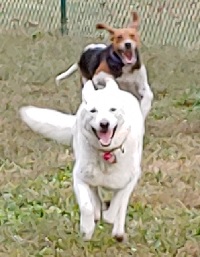 When the play combination is right, it is a pure joy -- for them and for us! Look at the smiles on Tilly and the hound Max who's chasing her! The problem is that most dogs are not this happy with EVERY other dog. As dogs reach social maturity, their tastes in playmates starts to narrow -- they like some, don't care about others, and just plain dislike others. So taking them to dog runs and parks is complicated and potentially dangerous because meeting a raucous party of unfamiliar other dogs is a mixed bag. Further, each of us has to find the dogs who mix well with our dogs and who our dogs mix well with, making sure that our dogs are not bullied but also that they themselves are not bullies. That's why setting up play dates with specific players can provide safer and more fulfilling interactions. The matchmaking is definitely worth it when you see smiles like those on Tilly's and Max's faces!
When the play combination is right, it is a pure joy -- for them and for us! Look at the smiles on Tilly and the hound Max who's chasing her! The problem is that most dogs are not this happy with EVERY other dog. As dogs reach social maturity, their tastes in playmates starts to narrow -- they like some, don't care about others, and just plain dislike others. So taking them to dog runs and parks is complicated and potentially dangerous because meeting a raucous party of unfamiliar other dogs is a mixed bag. Further, each of us has to find the dogs who mix well with our dogs and who our dogs mix well with, making sure that our dogs are not bullied but also that they themselves are not bullies. That's why setting up play dates with specific players can provide safer and more fulfilling interactions. The matchmaking is definitely worth it when you see smiles like those on Tilly's and Max's faces!
The Reactive Dog... 23 September 2019
When a dog has fears, wouldn't it be great if he sought the direction and comfort of his handler rather than taking matters into his own paws?! When dogs are reactive in the face of their fears, we become embarrassed, even angry, at their behavior. After all, from our perspective, we expect fear to look more like shrinking away from the trigger, so reactivity looks more like they're being offensive in their aggression. In fact, from their perspective, the best defense is often a good, strong offense. But if we teach them that we will take responsibility for their safety, then we can relieve their anxiety and angst and eliminate their reactivity. More peaceful for both ends of the leash!
Soul Pet in the Making... 20 Septebmer 2019
 Over the course of a relationship, we make compromises -- make room for the other's foibles -- and so a soul-pet is made. As we each lean into the ways of the other, we become a perfect fit together. And such was the story of sweet Sadie! She is just about the perfect dog, with a few foibles just like any dog, but the soul-pet of her household.
Over the course of a relationship, we make compromises -- make room for the other's foibles -- and so a soul-pet is made. As we each lean into the ways of the other, we become a perfect fit together. And such was the story of sweet Sadie! She is just about the perfect dog, with a few foibles just like any dog, but the soul-pet of her household.
And then all hell broke loose! She got a new little doggie brother who is an ever-ready wigglebutt and life got a little more exciting! So the training began... Of course for her bro Bailey, but also for Sadie herself. Because sometimes those little foibles get exaggerated when there's a partner in crime.
The more dogs there are in a household, the more the need for training, because each dog's foibles seem to be contagious to the others in the household. So keep in mind that, if you're considering expanding your household, it will take more of your own time to train the old as well as the new members. The effort will be well worth it!
Working with a Shy Dog... 18 September 2019
When doing behavior modification, it is not only important to give the dog situations in which she can be successful but also to exercise management in the situations that would be too great a challenge for her to succeed in. So, when working with a dog scared of new people, it's important to design what I call a "hierarchy of intimacy". Those who are her closest intimates are at the pinnacle of that hierarchy. Next would be perhaps close friends or family, those with whom she's comfortable but are not her direct family. And then each step down the hierarchy gets slightly more challenging. You should work at the level of the hierarchy of intimacy where she is successful and comfortable and step down each next wrung gradually and thoroughly, building her comfort there. For those who are too much of a challenge, management would be to provide her with a crate or room where she can be, having a good time on her own. Slow and steady wins this race.
Nosy... 16 September 2019
Dogs have 300 million olfactory receptors in their noses, compared to a measly 6 million in ours. Further, 40 times more of a dog's brain is devoted to his sense of smell than ours, proportionally speaking. So what does all this translate to functionally? Well, a dog's sense of smell is 10,000 to 100,000 more acute than ours. Even at the low end of that, using vision as an analogy, that means that if we can see something 1/3 of a mile away, a dog can see it at more than 3000 miles away. Astounding, right?!
Given this natural gift that dogs have, shouldn't we exploit it more, especially in our efforts to enrich their lives and exercise their minds? After all, given how much brain capacity is devoted to their sense of smell, activities involving the nose are very directly engaging their brains.
NoseWork is a sport involving sniffing out treats hidden among boxes. Gradually, the boxes can be nested and hidden more elaborately so that the dog has to work harder and harder to sniff out the treats. And, while NoseWork is actually a canine competitive sport, it can also be done just for fun in the home. And it makes for a great rainy/snowy day activity!
Ask permission... 9 September 2019
Recent clients of mine reported that their dog could sometimes be a little mouthy when they petted her, and since they were expecting a baby soon, they wanted to take care of that right away. So I asked them to show me and, as they petted her for a bit, she started to put her mouth on the hand ever so softly. Their dog was saying in a very inhibited way: "No, thank you! Not right now."
Dogs need to be asked and then given the opportunity to consent to being touched. So try an experiment with your dog... pet him/her for 5 seconds, then stop. What behavior do you see? Does s/he turn toward you as if asking "Hey, why'd you stop?!" Does s/he nudge or paw your hand or press against you? OR doesn't s/he?! Instead, does s/he move away in a "thanks, gotta go!" gesture? Or does s/he simply not move one way or the other -- "I'm really comfortable here and don't need any petting right now, thanks." As subtle as these gestures may seem, your dog is telling you exactly what s/he wants. If that communication is overlooked, then escalation, like mouthing, may follow. And not only is it a good idea to ask the question the first time; you should continue to ask and wait for a reply, because, as you well know, being stroked over and over in the same spot can become frustrating, even uncomfortable! So make these interactions dynamic and respectful.
The Noisy Behaviors... 13 August 2019
One of the biggest problems when training a dog is that the bad behaviors are the noisy ones; the good behaviors tend to be the quiet ones. When a dog offers a polite behavior, like a down, we often overlook it because it's not disruptive. But when a dog barks at us or jumps up to get attention, these "noisy" behaviors tend to get our attention, even if it's negative attention. We need to flip this process on its head. We need to praise and reward the good, quiet behaviors and try to ignore or remove our attention for the bad.
Beha-Rhythms... 12 August 2019
It is in the early months of having a new dog or puppy that behavioral rhythms -- shall we call them beha-rhythms?! -- are established. One pattern that is particularly helpful with large breed dogs is that being inside is an OFF switch. There's nothing worse than having a big, crazy whirling dervish dog in the house! We want whirling to happen OUTside, not inside. So from the very start, make sure that play and exercise happen outside so that, when the pooch comes back inside, he's knackered and ready for a nap. Establishing this beha-rhythm will hold you in good stead over the lifetime of your large breed dog.
Can an Old Dog Learn New Tricks?... 31 July 2019
Can an old dog learn new tricks?! Well, yes! The tricky part about training an older dog is that OLD habits need to be changed, for both dog AND human! If demand barking resulted in hush money before -- by way of treats or play -- it will take a while to extinguish this expectation in the dog and this placation in the human. And consistency is crucial for success.
So the question really is, you old-dog parents, can you, the old human, learn the new trick of not reinforcing unwanted behavior?!
Motivators... 30 July 2019
We all -- dogs and people, and cats and horses for that matter! -- learn by the same learning principles. The chief difference is what motivates each of us. While we humans find money a good motivator, dogs perhaps prefer little chunks of hotdog or cheese, cats might prefer a little flake of tuna or bonito, and horses like slices of carrots or apples. So very often the reason that an animal might be (what we call) "stubborn" is that we have not found his motivator. Paying pennies (kibble) for a hard lesson will not produce the results that paying big bucks (maybe boiled chicken?) might. So before you label your dog stubborn and insubordinate, pull out the big bills and see if things change!
Thunderstorm Phobia... 22 July 2019
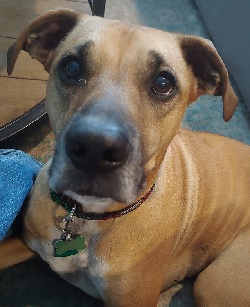 Yup, there's a thunderstorm happening right at the time of this pic. Layla is not a big fan of the sound of thunder -- she tends to panic and hide and wait them out -- but she IS a big fan of training games! Fortunately, training games actually outweigh her concern about thunder, and playing those games with visitors?... well, that constellation of events is just off the charts for Layla!
Yup, there's a thunderstorm happening right at the time of this pic. Layla is not a big fan of the sound of thunder -- she tends to panic and hide and wait them out -- but she IS a big fan of training games! Fortunately, training games actually outweigh her concern about thunder, and playing those games with visitors?... well, that constellation of events is just off the charts for Layla!
The time to solve a thunderstorm phobia is as soon as you notice it. Waiting and hoping that it goes away on its own is only allowing it to become a much more serious issue. What may start as a sensitivity to the auditory elements of a storm can escalate into an absolute panic as soon as she detects the pressure changes that precede a storm and go on from there. So don't wait to work on it!
Service Dogs... 15 July 2019
 This is Pie and she is a very special dog indeed. Recently adopted and specially selected to be a service dog for her mom, Pie has a lot to learn in the coming weeks and months.
This is Pie and she is a very special dog indeed. Recently adopted and specially selected to be a service dog for her mom, Pie has a lot to learn in the coming weeks and months.
Service dogs are more than pets; they are essential working partners to their humans. They require a special combination of traits: confidence and not easily fazed while also having a tendency to bond to their humans. And because of the need for them to have an interest and intelligence for training, it certainly helps if they are food-motivated, too! There may be physical requirements as well, since some jobs require size and strength. In Pie's case, her diminutive size is perfectly fine and it makes it easier to take her everywhere she might need to go.
Sweet as Pie, this little gal will soon be wearing the cape of a super-dog! But then all of our dogs are superheroes to us, whether service dogs like Pie or just devoted canine family members!
Misunderstandings... 11 July 2019
The amazing thing about dogs is that they have co-evolved with us over a period of thousands of years (the exact number of thousands is still in debate)! We would not be the humans we are today were it not for dogs being at our sides, and, obviously, dogs would not be dogs were it not for the relationship that they have with us. That is truly astounding, right?!
Well, because of the depth of that relationship between dogs and their people, they very often need our guidance and parenting to know how to respond to certain circumstances. And stress is cumulative, so even little stressors, when added to a long list of stressors, can take their toll. So often the road to happiness is paved with many small changes. And sometimes, when you get the ball rolling in a different, more constructive direction, the turn-around can be fast! And it promises a better partnership between dog and handler.
Too often we misunderstand our dogs' behavior, not realizing that a situation is causing them anxiety, and thus we're confused and disappointed when they are not the friendly, social dog we expect them to be.
Relationships are not Static... 8 July 2019
 This is Macy, a 7 year old boxer. A sweet, shy gal who gets along beautifully with other dogs and who has lived happily with other dogs in the past, Macy is having some trouble with her boxer "brother". As he has attacked her a couple of times over resources, she has become more insecure and worried in her own home. Her loving family wants to restore peace to the household, helping Macy feel more comfortable and at ease, while also helping her bro to feel less insecure and guardy around resources.
This is Macy, a 7 year old boxer. A sweet, shy gal who gets along beautifully with other dogs and who has lived happily with other dogs in the past, Macy is having some trouble with her boxer "brother". As he has attacked her a couple of times over resources, she has become more insecure and worried in her own home. Her loving family wants to restore peace to the household, helping Macy feel more comfortable and at ease, while also helping her bro to feel less insecure and guardy around resources.
Such situations are complex because they involve the relationships between the canine as well as the human family members. Further, such relationships are not static and may change over time, so practicing good, active parenting is crucial to creating a happy, safe home for everyone.
Multi-Dog Family... 3 July 2019
Training in a multi-dog household is exponentially more complicated! First you must train each dog separately before starting to train them together.
In a home of three or four dogs? Well, get ready! Once each is trained separately, then each set of two must be trained, then each set of three, and so on, and so on! With three dogs, that is seven combinations. And with four dogs, it's 25! Ugh! Granted, the training gets faster with more practice, and some dogs are much easier to add to the mix than others.
But the moral to this story is: Don't bring into your family more dogs than you are willing to train!
The Dangers of "Stubborn"... 2 July 2019
While little dogs are often uncomfortable in a "down" -- they can be sensitive to the surface touching their bellies -- and may prefer to "sit", larger dogs usually prefer the "down" position, especially when they're on a slippery floor where their legs might continue to slip away from them in a "sit".
Don't assume your dog is being stubborn or recalcitrant just because he does not do as you bid. There may be physical considerations for his choice.
Puppy Play... 21 June 2019
In honor of the start of summer, let's talk PUPPY PLAY! There's no better teacher for a puppy than an appropriate adult. Adults like this are a gift and I am happy to say that I have one in Tilly!
Tilly played with two puppies on a recent walk... First she met an exuberant 6 month old hound mix. This puppy was playful and rambunctious and Tilly gave perfectly timed and appropriate corrections to the puppy to say, "Hey, little whippersnapper, a little respect please! That's not how it's done." Adults can be great at setting boundaries with puppies who are pushy and obnoxious without being overly corrective or harsh.
Then Tilly met a shy 4 month old golden who was a little growlie and uncomfortable at the start. A confident dog like Tilly can be a great role model and partner for such a puppy, as the puppy could see that Tilly was not worried about the environment and so the puppy emulated and followed her. Further, Tilly gave the puppy plenty of time to warm up to her, simply coexisting with her and engaging in low-key activities like sniffing and trotting along.
If you have a puppy, socialization is important but APPROPRIATE socialization is crucial. Putting a puppy into a mix of rough, obnoxious hooligans or, conversely, into a group of shy, nervous nellies can be teaching her all the wrong lessons and puppyhood is a most impressionable time. So search for the best playmates you can find to help your puppy with this early education.
Paw-litics... 17 June 2019
For some reason, we humans expect dogs to meet any and every dog they pass on the street without an issue. But this is really akin to us walking down the street kissing every stranger WE pass... ludicrous, right?! Why do we expect our dogs to be more social than we ourselves are? It is only the special "mayor" dog who thrives in such situations.
In fact, the way we traverse our city streets, in straight lines, is encouraging rude approach in doggy "pawlitics". Polite dogs, when approaching one another, will arc in to each other, showing their peaceful intents. In contract, rude greeters go in a beeline straight at the other dog. So, when our dogs approach each other on our streets of straight lines and perpendicular intersections, they are repeatedly practicing a rude approach. No wonder they get uncomfortable, even defensive, with the direct eye contact of an approaching dog!
Hyper Much?!... 7 June 2019
 This is Booth, the Boxer. His eyes are bugging out of his head and his mind is exploding! The rules of engagement have just changed for Booth and he is quickly trying to recal-culate. Up until now, jumping and running around the furniture has gotten him the attention he so craved. Now he's discovering that's not working any more and that other things work better, like lying down quietly.
This is Booth, the Boxer. His eyes are bugging out of his head and his mind is exploding! The rules of engagement have just changed for Booth and he is quickly trying to recal-culate. Up until now, jumping and running around the furniture has gotten him the attention he so craved. Now he's discovering that's not working any more and that other things work better, like lying down quietly.
Booth gets himself into quite a lather of excitement -- he's just beside himself! But teaching him these more calm behaviors will help him get a hold of himself. As annoying as his frenetic behavior might be to the human recipients, it's none too comfortable for him either... hence the eyes popping out of his head and the fast, dry pant!
Dogs not only need our help to be their best selves for our sakes; they also need our help to learn how to take life's surprises and excitement in stride, for their sakes.
Toy Economics... 4 June 2019
Puppies need to learn early on the principles of toy economics. When we take things away from our dogs, we are teaching them that sharing with us means losing access to things. Instead, it's important that we trade one toy for another or a treat for a toy. Or, best of all, giving up their toy results in a tasty treat, then they get the original toy back! Who wouldn't want to share with those kinds of return on investment?! A veritable Standard and Paws!
Fear of People who are Scared of Dogs... 3 June 2019
Some dogs are a little worried about new people and particularly of people who are scared of them. Much of the human body language associated with fear -- eyes wide, staring, frozen body, holding our breath -- are aggressive displays in dog body language.
We assume that dogs are aggressive towards people who are scared of dogs because they smell their fear and realize that they can get the perceived "upper paw". But, while dogs likely can smell fear, it is more likely that the body language of fearful humans is triggering a defensive aggressive reaction because they perceive the human as showing aggressive behavior. Funny how we get that backwards and assume that dogs have world domination in mind, right?
Marking... 20 May 2019
So many dogs mark as they walk, leaving pmail on every tree they pass. A walk becomes an exercise (if you can really call it that) in ambling, then stopping, ambling and stopping. So should you let your dog mark? No, I don't think so. This is an act of neighborhood paw-litics! Marking is sending a territorial message to other passing dogs. Is your dog reactive towards other dogs in the blocks near your house but more subdued in unfamiliar neighborhoods? That there is territorial paw-litics at work! Your dogs feels emboldened in his own territory.
Typically a dog will have voided his bladder in two, maybe three, pees. So as you begin your walk, give him a couple of opportunities to go; then walk! You might also want to allow him one final pee before returning inside, just to make sure.
To Walk or To Sniff? That is the Question... 13 May 2019
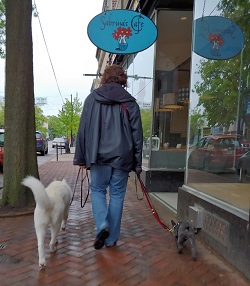 There has been a recent flurry of articles about the importance of allowing a dog to sniff while on a walk, that it provides them with invaluable mental stimulation and that it also produces opti-mism in our dogs. (*) Here's the problem though. Our dogs also need exercise, so allowing your dog to continually stop and sniff is not providing for their physical needs.
There has been a recent flurry of articles about the importance of allowing a dog to sniff while on a walk, that it provides them with invaluable mental stimulation and that it also produces opti-mism in our dogs. (*) Here's the problem though. Our dogs also need exercise, so allowing your dog to continually stop and sniff is not providing for their physical needs.
So what do we make of this conundrum? To walk or to sniff?... Now that is truly the question! Walks with my dog are a shared experience; we are sharing the world together in that moment, though in different ways. While I use my sight more prominently, my dog uses her sense of smell more prominently. Still, it is for both of our benefits and both of our enjoyment.
Here it is from another angle... If I were walking with my husband and he needed to stop to send a work text, that would be understandable; but if he stopped every few feet to send another and another, I would go bananas! He should be working, not out for a walk! A walk with my dog is the same. Giving an opportunity for a particularly interesting sniff at a favorite tree is one thing, but stopping every few feet to sniff is just not what I call a walk.
So my solution is this: I have two different cues at the start of a walk -- "let's go" and "go free". The first is a walk with purpose, with only the occasional stop for a sniff; the latter is completely at my dog's discretion, letting her stop where she wants. This sets the expectation for both of us.
Truly, there is great value in including games of scenting into a dog's day. NoseWork is one such game; "go find it!" is another (see my article Games to Play with Your Dog). And these games can even be played in the house, making them especially useful when the weather is inclement.
(*) (This is a finding reported in an article on Companion Animal Psychology called “Finding Hidden Food in Nosework Increases Dogs' Optimism: Opportunities to use the nose and make choices in nosework are good for dogs' welfare" by Dr. Zazie Todd, that summarizes a research paper by Drs. Charlotte Duranton and Alexandra Horowitz called "Let me sniff! Nosework induces positive judgment bias in pet dogs" in the journal Applied Animal Behavioural Science.)
Barking Works!... 22 April 2019
Dogs who bark at passing people and dogs outside the window think they are keeping them away. The problem is that the behavior works... no one comes in! And, shy dogs may use the same technique on the street to keep people and dogs at bay. Guess what?! That works there, too. Not a lot of people stop to talk when your dog is barking at them! (Check out WoofGang's dog blog about territorial behavior.) Compounding the problem is that barking is self-reinforcing... the more dogs bark, the more they enjoy barking and the more they bark.
The thing to consider is that it's not good for the barker AND it's not good for the passerby dogs on the receiving end either! Many dogs find it upsetting, even scary. My dog immediately gets anxious when walking past particular houses in our neighborhood, even before an assault begins.
So what can be done? Well, how about closing the blinds or curtains? Or you can mount a decorative window skin that allows light in but obscures the view looking out. Or just keep the dog from the room with the windows entirely. For a dog in the yard, put up bamboo fencing as a blind on the parts of the yard that have sight of passersby.
Stubbornness, or Not... 15 April 2019
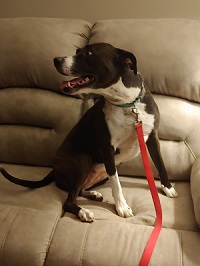 Sometimes we may misconstrue a dog's behavior as noncompliance when it may instead be due to a physical limitation. Mimi, a 7 year old mutt, was avoidant of sitting, dancing around and away from the cue. Turns out this gal found it difficult and uncomfortable to sit on the hardwood floors. When cued to sit while on the couch, she did so without hesitation.
Sometimes we may misconstrue a dog's behavior as noncompliance when it may instead be due to a physical limitation. Mimi, a 7 year old mutt, was avoidant of sitting, dancing around and away from the cue. Turns out this gal found it difficult and uncomfortable to sit on the hardwood floors. When cued to sit while on the couch, she did so without hesitation.
Before accusing your dog of being stubborn or obstinate, consider whether your dog is physically capable of doing what you're requesting, whether you're sure your dog knows what you're asking her to do, AND that you're paying in a currency that motivates her. All too often, we peg a dog as being "stubborn" when the real problem is that we either aren't offering them a reinforcer that interests them or we're only offering pennies for a job that warrants a high wage.
Tricks... 25 March 2019
 When I was first starting out as a dog trainer, I had no respect for dog tricks. As far as I was concerned, tricks training was just fluff, mankind's way of manipulating dogs to be even more adorable than they already were -- as if that was necessary!
When I was first starting out as a dog trainer, I had no respect for dog tricks. As far as I was concerned, tricks training was just fluff, mankind's way of manipulating dogs to be even more adorable than they already were -- as if that was necessary!
These days, I include tricks as part of every training protocol. For starters, for large-breed dogs, and particularly for "scary" breeds like pits and rots and sheps, tricks are a great way to make people more comfortable in their presence. Who can be scared of a dog who waves goodbye or plays dead on cue?! Even just a few tricks in a pup's repertoire can help put people at ease.
Further, tricks can affect an emotional shift in a dog through physical means. Should your pup get anxious or upset by something, a trick can be the perfect way to get his mind off it and onto something else, something much more fun!
And perhaps most importantly, from the behavior modification standpoint, some tricks are a wonderful way of affecting change in problematic behavior.
Oh, just as an aside, as if you needed more convincing, they can be a great source of exercise, both mental and physical!
The Older Dog... 18 March 2019
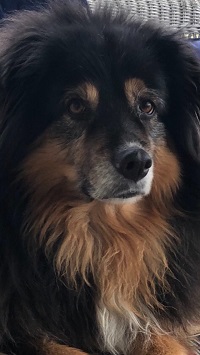 This handsome gent is George, a 9 year old Australian Shepherd. George has been living a wonderful life with a loving, doting family but he had a shock a few months ago when his sister (and littermate) Penny died. Then a shadow came across George's perfect life. He became increasingly anxious, almost inconsolable at times, and his family was desperate to help him find some relief.
This handsome gent is George, a 9 year old Australian Shepherd. George has been living a wonderful life with a loving, doting family but he had a shock a few months ago when his sister (and littermate) Penny died. Then a shadow came across George's perfect life. He became increasingly anxious, almost inconsolable at times, and his family was desperate to help him find some relief.
Older dogs are less resilient to changes in their routine than younger dogs are, so even seemingly innocuous circumstances -- like moving to a new home, the addition of a family member or the absence of one, even a change in a work schedule -- can upset their equilibrium. In situations where there can be some preparation, like the anticipation of a new baby, it can help to morph the family rhythms and routines gradually, thus helping the canine family member adjust over time. But when sudden life changes occur that result in profound changes to your dog's behavior, it is important to respond quickly.
The first phone call to make after a sudden behavior change is your vet. Behavior changes can be caused by an undiagnosed medical issue. Once your dog has been granted a clean bill of health, the next call to make is to a certified behavior specialist who can help you find ways to assuage your pet's new needs.
As for George, he LOVED the new games and skills we taught him. You truly can teach an old dog new tricks... and have a great time doing it!
Dogs with Issues... 12 March 2019
Who among us doesn't have some issue(s) we're working on?! As cute as this is, there's also quite a bit of truth to it. Dogs are way more forgiving of us than we are of them! We don't seem to understand or empathize with the frailties and challenges of our dogs, particularly with those dogs who are fear aggressive. Some trainers will even espouse using punitive training techniques for working with these types of problems, and dog owners, not knowing any better, will comply. I think the reason is because fear aggression looks just so -- well, AGGRESSIVE -- to us! We don't recognize it for what it is because it doesn't look like how humans usually express it. And for precisely that reason, we feel no compunctions about punishing for it.
Fear-based behaviors are the most critical to use positive rather than punitive techniques in treatment. The learner must learn that the object of fear predicts good -- WONDERFUL even! -- not bad outcomes!
Kitty Burrito... 11 March 2019
Our kitty Steffi had to go to the vet recently, having somehow pulled one of her claws from its nail bed. Turns out this is pretty painful, even just any minor handling of that digit. What made it easier for all involved was that, all along the way, we've made being wrapped in towels and blankets cozy and comfortable. We will pick her up, wrap her like a little taco, and then cuddle and pet her in all her favorite ways. So, at the vet's office, wrapping her was a comfort, even as they manipulated that toe and, once home, wrapping her to clean and examine her toe was easy and safe and much less traumatic for her than it might otherwise have been.
There are so many easy ways we can prepare our pets for the eventualities of veterinary handling and the other challenges they may face.
Sibling Politics... 25 February 2019
Child psychologists recommend that parents must shape and guide the relationships between their children, making sure they're respectful, constructive and loving, not interacting with bullying, jealousy or rivalry. The same is true in households with "siblings" of different species, whether they be canine, feline, or human.
Our household includes Tilly, our Shepherd, and two cats named Steffi and Django. As heartwarming as it is to see them together now, don't think for a second it was easy getting here. Especially upon the arrival of each to the household, it took constant parenting!
Tilly was an adolescent when she joined our family. Her resident sibling was a cranky 17 year old cat who took little guff from anyone. Tilly was on leash at all times when Jazzi was about in those early months. Shaping her to be this tolerant and respectful a dog with cats was quite a project and it could have gone just as easily in another direction.
Steffi and Django joined the household together but, as they grew, their sizes and activity levels diverged. To keep family harmony, Django needed a lot of interactive play with us humans so that he didn't roughhouse and overwhelm his little sister.
And, of course, human children need to have the same guidance in their interactions with the family pets.
The more who join the household, the more complicated the family dynamics. Remember this when you are balancing your desire for another pet with your current household responsibilities!
Check out WoofGang article Keeping the Peace in a Multi-Animal Household.
Sharing... 15 February 2019
It's important that dogs learn to share. Teaching a "drop it" behavior can help with this because, upon dropping the toy, the pup gets a treat and then the toy is returned to them... a win-win! Why wouldn't they want to share when the item they've dropped gets promptly returned to them and they earn a nummy treat in the process!
A word of caution, though... Using a "drop it" cue for things that a puppy might pick up on a walk, like leaves and sticks, is actually ENCOURAGING picking up these items. So, for items that might become a pattern like this would be better handled by using attention exercises and distraction.
Anxious Franco... 13 February 2019
When Franco, the Chihuahua / Min Pin mix, moved to a new home and new city with his mom, she noticed that sweet Franco had become anxious and upset. At first she thought he might just need to settle in, but it soon became apparent that he was having difficulty adjusting. He would become particularly upset and aroused with people's arrivals and departures from the home. In this pic, Franco is learning a different way to receive visitors.
When behaviors change and issues start to emerge, while we can hope that it will simply go away on its own, this is unfortunately very rarely the case. And the sooner that new patterns are established, the better. We want the good patterns to be practiced, not the bad ones.
So if your canine companion suddenly starts to show a new, undesirable behavior, first visit your vet. Sometimes behavior changes, especially sudden ones, have medical causes. Then, if all checks out, find a certified behavior specialist to help your loved canine family member be his better self!
Vinny at the Door... 11 February 2019
Vinny, the Maltese, gets super-excited when visitors arrive, barking like a banshee -- unbecoming for such handsome boy. Just because he's 5 years old doesn't mean that he can't learn a new way of receiving people! And he was hungry for the challenge (well, yes, and the cheese ;) )
We can't get frustrated and angry at our dogs for showing bad behavior if we haven't taught them any alternatives! Impulse control exercises teach dogs to offer preferable behaviors in order to get the things in life they want.
Further, these exercises build frustration tolerance. Frustration happens because a dog doesn't know how to affect their own destiny, how to make good things happen for themselves. But if we equip them with better answers, then they can offer those things instead of a banshee-dance.
Proofing Behaviors... 7 February 2019
Clients often ask how much training they should do each day and, when first teaching new behaviors, doing training sessions is certainly a requirement. It is better to do short 5-10 minute training sessions 3 or 4 times each day than it is to do an hour all at one time. That leaves them wanting more and it doesn't exhaust them to the point of not participating.
But once a behavior is fluent, the tenor of training can change as you "proof" cues in different settings. On a recent hike, I worked with Tilly on a long-distance sit-stay in a highly distracting environment and off-leash. She needs to know that, regardless of the environment AND my proximity to her AND whether she is restrained by a leash or not, a sit-stay is a sit-stay. Of course, I couldn't possibly ask her to withstand Distance, Duration and Distraction (the 3Ds of dog training) all at once without gradual progression, or she would fail every time!
So that one sit-stay, on a beautiful path on an incredibly gorgeous spring-like day with two besties together, was the extent of our training for that minute.
Luna's New World... 29 January 2019
 This is Luna, a recent arrival from Puerto Rico who was adopted by a wonderful, loving family. Street life took its toll on this little sweetheart, and they are trying to help her navigate her way in a world very different from the one she was used to. Luna is uncomfortable with certain handling, with people around some of her resources, and with meeting new people. A lack of trust is at the root of the first two problems and under-socialization is to blame for her fear of new people. Training is a great way to help build trust and bond, and to install new responses to situations that Luna finds challenging.
This is Luna, a recent arrival from Puerto Rico who was adopted by a wonderful, loving family. Street life took its toll on this little sweetheart, and they are trying to help her navigate her way in a world very different from the one she was used to. Luna is uncomfortable with certain handling, with people around some of her resources, and with meeting new people. A lack of trust is at the root of the first two problems and under-socialization is to blame for her fear of new people. Training is a great way to help build trust and bond, and to install new responses to situations that Luna finds challenging.
WoofGang's mission is to help dogs and their people gain trust, love, and respect and understanding in their relationships with each other.
Expressions of Arousal... 28 January 2019
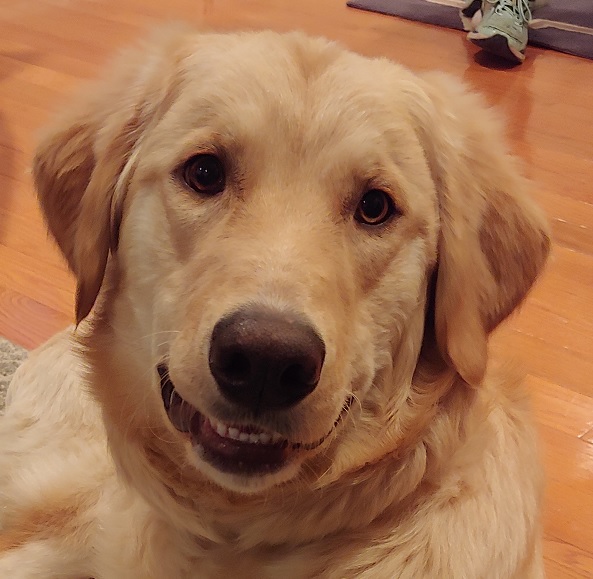 This is Sandi, a Golden mix and recent adoptee. Look at the smile on that face during her training session! Sandi is highly motivated to work and her new family is happy to provide her with the opportunities.
This is Sandi, a Golden mix and recent adoptee. Look at the smile on that face during her training session! Sandi is highly motivated to work and her new family is happy to provide her with the opportunities.
Because an animal shelter is such an arousing, unsettling place for a dog, it can affect behavior, even after adoption. Some dogs may jump or hump, mouth (sometimes hard enough to bruise!) or even spin. In Sandi's case, she has a tendency to bite her leash when she gets aroused, and sometimes she will chase her tail. And tail-chasing can become a compulsive behavior so it is important to try to interrupt this tendency quickly, which is exactly why Sandi's loving family wanted to start training right away.
Just as humans need to practice techniques for mastering their levels of arousal, so must dogs -- though they themselves may not see it as an issue that needs solving! In fact, arousal can be risky to those on the receiving end of it, so exercises in impulse control can help decrease arousal while also building frustration tolerance and just general politeness.
Chunking a Puppy's Day... 24 January 2019
A puppy's day is a repeated time chunk of: coming out of the crate, going out to the potty, then some play or a walk to poop her out, and returned to her crate for a stuffed puzzle toy and a nap. When they are young, the length of this time chunk is short -- they have little stamina and they need to potty often -- and repeated many times throughout the day. As they grow and their stamina grows, this same time chunk becomes longer -- longer play, longer nap -- but fewer throughout the day.
Conducting your day like this has many advantages:
- They are getting periodic potty opportunities (dare I say pooportunities?!) so they have fewer accidents.
- They are going into their crates after some tiring exercise with something fun to work on, so it is a restful place associated with good things.
- They are learning to direct their mouthy behavior on appropriate targets because that's all they have available to them.
- Rambunctious play happens in the appropriate place; rest happens in its appropriate place.
It's never too early to start training your puppy to be a model canine citizen!
Two Important Off-Leash Cues... 21 January 2019
When off-leash, there are two key behaviors that I rely on: "wait" and a recall. "Wait" means to stop forward movement. The dog can go backwards, can stand or sit, anything BUT move forward past the cued threshold. So, for instance, at an intersection, "wait" would be to stop at the curb or, at the door, to stop at the threshold. In both cases, you can see that it would be safe for the dog to go backwards, away from the street or back further into the house, but not forward.
I like the "wait" behavior because it allows the dog choice of some movement at a time when an absolute stop might be frustrating. When it becomes an automatic behavior, the mere word will stop the dog and change her direction, often boomeranging her back towards the handler.
Note: As you're working on your dog's reliability off-leash, using a cotton web long line is a great way to get some distance in a distracting environment while still maintaining some control.
Crate-Training Advantages... 17 January 2019
I have heard more than a few people say that the crate is cruel, that it is a prison for a dog. In fact, I have spoken to people surrendering their dog to the shelter because he was destructive in the house but refused to crate-train him because they perceived it as cruel. Go figure...
Anyway, I cover Tilly's ears when such words are spoken. And she didn't get the memo, either... she will go in and zonk out in her crate on her own.
The crate is an incredibly helpful piece of equipment in dog training. It is a place where a dog cannot make a mistake because there is nothing available to them that they can't have. In a household of little kids, it is a place where they can seek out for some alone time. And for Tilly, it is an "off" switch. When she goes in there, her lights go out... it is her sleepy place.
Obviously we want our dogs to LOVE their crates. Putting them in a space where they don't want to be IS a prison, no matter the size. So we need to introduce them to the crate gradually and with happy associations. Need help crate-training your dog? Check out WoofGang's crate-training handout.
Training Advantages... 16 January 2019
Training not only helps a dog learn our vocabulary of cues and our expectations; it also helps us be sensitive to the biorhythms of our new dog. We can become more attuned to the fluctuations in energy and needs over the course of the day. If, for example, a dog gets what I call "8 o'clock crazies" at about the same time of day each evening, that can tell us that our schedule is not satisfying his needs; he might benefit from a bit of exercise just a little in advance of this witching hour.
Training is a 2-way street, a feedback loop of information. And it is the language that binds!
Multi-Dog Households... 14 January 2019
While there are so many advantages to having multiple dogs in a household -- company, conspecific social interaction, exercise and play -- there are also disadvantages that bear consideration:
Rude Play Patterns
With puppies, the play experiences they have in their early formative months are going to teach them patterns and playstyles that they will take with them into adulthood. Puppy play, by definition, is investigative and often obnoxious as a puppy learns what appropriate limits are, so he requires guidance to learn these important lessons. When a puppy plays with his sibling housemate to the exclusion of other playmates, even if that is a tolerant adult dog, he can learn habits that he will then practice with unfamiliar dogs who may be less tolerant and, as he ages, this can get him into trouble with the world of dogs at large. Make sure the puppy gets plenty of individual play experiences with unfamiliar dogs and puppies.
Littermate Play
Poodles have one playstyle and it is quite different from shepherds and from boxers, and so on. So littermates usually have similar playstyles and, because they have such a long, intimate past with their sib, they develop their own play "language" and are very familiar with each other. When they play with each other exclusively and not enough with unfamiliar dogs, they are practicing this very familiar, stylized play over and over again, and this will become their pattern of play even with dogs they don't know. They do not learn to be respectful of other playstyles or play partners. They need to have separate play experiences with unfamiliar dogs.
Ganging Up on Other Dogs
Bonded sibling dogs can start to act as a pack to bully other dogs when in group play. The more the dogs practice this bullying pattern, the more that can become their style of play. If, when they play with other dogs, they gang up on the other player(s), then they should be separated, each given the opportunity for solo play with the other player(s) without the sibling present so that they learn respectful play behavior.
Secondary Bonding to the Human Family
Especially with littermates growing up together, puppies will often develop a bond first and foremost with their littermate and only secondarily with their human family members. It is important for littermates or puppies growing up together that each spends quality time alone with their human family and away from their sibling. A famous trainer, John Rogerson, once said that, when a new puppy enters his multi-dog family, that puppy only has a half an hour exposure to the other dogs in the family; 23 1/2 hours of his day are spent developing bond with his humans. While this may not be feasible in your family, you should at least have as a goal plenty of human-only interaction with each puppy.
Intolerance to Aloneness
Puppies who spend their time constantly in each other's company can develop a dependence on the presence of the sibling dog and an intolerance to aloneness. There will come a time when one or the other dog needs to be left alone, maybe when the other goes to the vet or the groomer, etc. So it is important that both dogs learn to tolerate periods of aloneness from their sibling as well as from their human family.
New Year's Resolution -- A Healthier Dog... 7 January 2019
With the start of the New Year, have you made some New Year's resolutions for your dog as well as for yourself? We all have a fresh opportunity to live better and healthier, but where to start for our dogs?! Here are a few ideas...
Build Your Relationship
Dogs have coevolved over thousands of years to live at our sides. It is not merely hyperbole to call them "man's best friend". This is the very reason for and cause of their evolution. If you don't have the connection you would like with your dog, it is not too late to build a deeper relationship, sharing both love and respect. Check out WoofGang's FB series The 8 Days of Enlightening for some ideas on types of reinforcement that can jumpstart your relationship with your canine companion.
Design an Exercise Regimen
Exercise is as important for our dogs as it is for us. Boredom, destructiveness and obesity, even reactivity, can all be symptoms of a life lacking in physical exercise. Walks and runs are absolutely essential: a young, medium- to large-breed dog typically needs 2 hours of exercise a day, with one quarter of that (i.e. a half hour) being aerobic in nature. Doing stretching and limbering activities can also help your dog get proprioceptive exercise. Check out WoofGang's Paw Pals article in this month's Kidz Buzz magazine.
(Consult with your vet about what exercises should be avoided due to any physical limitations your dog might have.)
Eat Healthy
Changing to a healthier diet can have a marked effect on behavior. We all know that when we're subsisting on junk food with low quality nutrition, we feel sluggish, tired and low energy. Or if our diets are high in sugar, there can be spikes and troughs in our energy. Our dogs can suffer these same consequences of a poor quality diet. Including fresh vegetables can be very healthful, and pumpkin can help with digestive stability. A raw or homemade diet can be great for some dogs, but for those dog parents who prefer the convenience of a prepared diet, Honest Kitchen can be a terrific alternative. Check out WoofGang's Canine Diet handout for information on reading an ingredient list.
(Consult with a veterinary nutritionist to get an individualized dietary plan for your pooch.)
Include Enrichment in the Daily Routine
Puzzle toys like the Kong toy or the Kong wobbler, The Busy Buddy Twist 'n Treat, and the WestPaw Toppl and Tux are just a few examples of terrific food puzzle toys that can give a dog a job to do for his food and snacks. If you need some tips on how to use these toys, check out WoofGang's Kong Stuffing handout. But puzzle toys are merely scratching the surface of ways you can enrich your dog's life. Check out WoofGang's FB series The 12 Days of Enrichment for some ideas on enriching activities that can share with your pooch.
Fine-Tune Your Training
Training is a way of building a shared vocabulary. We can't expect our dogs to be "good" if we haven't equipped them with how to make good choices for how to behave. And we can't include them in all of the elements of our lives if they are not trained in how to be polite, respectful, well-behaved companions. Training is the language that binds!
Christmas' 12 Days of Enrichment -- Building Relationship through Training... December 2018
Training is the language that binds! So, in celebration of the 12 Days of Christmas and the season of love and enrichment, WoofGang offers a gift each day that will deepen your relationship through enrichment and shared experience with your canine companion.
Since you know your dog better than anyone, you know his/her innate talents and tendencies, so employ the activities that will most interest your pooch.
- GIFT #1: Walks
- GIFT #2: Yard Games
- GIFT #3: Hikes
- GIFT #4: Running
- GIFT #5: Biking
- GIFT #6: NoseWork
- GIFT #7: Tricks
- GIFT #8: Water Sports
- GIFT #9: Adventure Coursing
- GIFT #10: Breed-Specific Sports
- GIFT #11: Treibball
- GIFT #12: Dog Sports
Recognizing Healthy Play... 17 December 2018
Take a look at the play interaction between "sibling" dogs Sailor (blue heeler) and Oliver (Lhasa).
It's so easy to mistake this for healthy play. After all, no one is upset, right?! In fact, this is dangerous play for Sailor to be practicing. Notice how often she bites Oliver's neck in this interaction. While she is being playful and inhibited here, she is also perfecting this behavior. When an actual altercation does ignite between these two (and they have had a few spats), guess where she's going to go for him?! The place she's been practicing all along... his neck!
Play is fun but it is also a practice of behavior, so it's important that you parent your pooch, even during play, insisting on the practice of healthy play practices.
The Allure of the Forbidden... 11 December 2018
Why do dogs love to pick up the things they're not allowed to have, like hats and socks? Well, that has more to do with OUR behavior than with theirs. When dogs pick up their own toys, we rarely pay any attention at all; after all, that doesn't bother us. But when they pick up something of ours, we are suddenly activated into a great game of chase! Now do you see why dogs love to grab the things they shouldn't have? Because WE make it fun for them.
Time to turn things right-side up... When a dog picks up her toy, pay lots of attention, get really fun and start playing with her! What could be more fun than interactive play with a toy?! But when she picks up something she shouldn't have, ask her calmly to "drop it" and return something else to her. Now, that's no fun. Better off picking up a toy next time, right?!
Hanukkah's 8 Days of Enlightening -- Building Relationship through Training... December 2018
Training is the language that binds! So, in celebration of the 8 Days of Hanukkah and the Festival of Lights and Enlightening, WoofGang offers a gift each day that will jumpstart training with your canine companion.
Reinforcers (i.e. rewards) are in the eye of the receiver, so what some dogs will work for others will NOT. Since you know your dog better than anyone, employ the reinforcers that you know will interest your dog the most.
- GIFT #1: Food
- GIFT #2: Play
- GIFT #3: Adventures
- GIFT #4: The Environment
- GIFT #5: Other Dogs
- GIFT #6: Greeting People
- GIFT #7: Touch
- GIFT #8: Love
Cuddling... 30 November 2018
I can't tell you how many clients sheepishly respond that their dogs sleep in bed with them when I ask where their dogs sleep. It has long been a myth that dogs shouldn't sleep in bed with us because it promotes them in the family hierarchy. That really couldn't be further from the truth. In fact, there are studies that suggest there are actually advantages to having our dogs sleep in our beds. And how close to you your dog chooses to sleep is a good measure of the strength of your relationship and of his bond to you.
Of course, there are some exceptions. Dogs who guard the bed once they're in them should NOT have this benefit. After all, the bed belongs to the humans, not to the dog, so it is not his resource to guard, and it is not safe. Also dogs who lash out when jostled or startled out of sleep should not be sharing this space. And, finally, a dog who is not thoroughly housetrained should not be allowed in bed yet, as he may have an accident in the bed and that is something that would surely threaten the harmony within the family.
Ultimately what matters is what's best for you. Well, and for your dog, obviously...
The Game of Chase... 27 November 2018
 How can you tell if the chasee is enjoying the game?! Typically the clearest indicator is the tail carriage. Look at how Tilly's tail is waving and flashing, high like a flag. A dog who's getting scared and overwhelmed will usually start lowering/ tucking her tail and her body may lower and hunched into itself. This is not likely to happen with this duo, as Tilly is an adult and Lucy is just a puppy, ready to take correction if necessary.
How can you tell if the chasee is enjoying the game?! Typically the clearest indicator is the tail carriage. Look at how Tilly's tail is waving and flashing, high like a flag. A dog who's getting scared and overwhelmed will usually start lowering/ tucking her tail and her body may lower and hunched into itself. This is not likely to happen with this duo, as Tilly is an adult and Lucy is just a puppy, ready to take correction if necessary.
While a game of chase may start with a happy partnership, it can subtly change, especially if the chaser starts getting frustrated and more intense. Then you'll often see the chasee's tail drop lower, and that means it may be time to get involved. You can often give that dog a port in the storm, letting her shelter behind you as you block the chaser.
Belly Up!... 26 November 2018
 Belly rub request? Not likely! In behavior terms, this posture is called passive sub-mission or a tap-out. This is Diamond trying to avoid going to her crate. With her ears way back and her head tilted slightly away showing a little eye white, she does not have the loose, languid body of a dog ready to enjoy a belly rub.
Belly rub request? Not likely! In behavior terms, this posture is called passive sub-mission or a tap-out. This is Diamond trying to avoid going to her crate. With her ears way back and her head tilted slightly away showing a little eye white, she does not have the loose, languid body of a dog ready to enjoy a belly rub.
The tap-out is one of the most misread and misunderstood expressions in dog body language, meant to avoid or "turn off" the behavior of another individual (in this case the human). If the receiver misunderstands or just blatantly ignores these expressions, it can cause a dog to escalate her message with mouthing, air-snapping, or worse. So, in short, reaching in here to grab Diamond's collar and force her into the crate would be disrespectful of her message and potentially dangerous.
What should we do then? Well, the immediate step here would be to release space, moving away from Diamond, and try to jolly her into following. The long-term goal should be to make Diamond happier about the time she spends in her crate.
BFFs... 23 November 2018
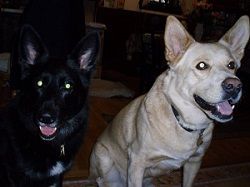 This is our old dog, Trista, with her BFF Max. Dogs can form deep bonds and friendships between them just as humans find in other special people.
This is our old dog, Trista, with her BFF Max. Dogs can form deep bonds and friendships between them just as humans find in other special people.
After social maturity, (somewhere between a year and a half and three, maybe four, years of age), most dogs prefer to spend time with close intimate dog friends rather than free-for-all play. We humans often make the mistake of assuming that, just because our dogs loved "playing the field" of dogs as puppies, this same play style will continue into their adulthood. We miss the signs that our adult dogs are finding such interactions less enjoyable as they age.
Dog behavior is dynamic, not static! As your dog's guardian, you must be attune to the signs that your dog's preferences are ever-changing. The important thing is to find the situations that make your dog his/her happiest.
It didn't take border collie intelligence to see how happy Trista and Max were to have each other!
The SECRET to Dog Training: Correction is NOT enough!... 19 November 2018
I am a positive trainer, so using positive reinforcement is my bag, but I will not tell you that using punishment to correct bad behavior doesn't work; it can work, but it's NOT nor is it EVER enough. All you've told your dog is what NOT to do; you have not equipped him with a better choice.
The best way to inhibit undesirable behaviors is to train a DRI (Differential Reinforcement of an Incompatible) behavior. For instance, instead of jumping up, wouldn't you prefer if your dog sat?!
SO, whenever you identify an undesirable behavior that you'd like to change, you must do two things!
1. Inhibit the behavior from happening.
2. Install an alternate behavior incompatible with the behavior you don't like (i.e. a DRI).
Ideally, try to visualize what you would rather your dog do instead of the bad behavior, because, for instance, while "sit" is a DRI to a lot of annoying behaviors, you might not want to keep interrupting your walk with sits all the time, right?! So, for some examples:
If your pooch jumps at visitors entering the home,
1. Leash him up, and
2. Reward him for sitting for visitor approach.
If your dog follows in the wake of passersby on walks,
1. Keep him close with your leash, and
2. Reinforce him for heeling at attention at your side.
If your pupster tries to edge past you to get out the door when you enter,
1. Body block, and
2. Train a "back up" behavior and reinforce with a toy thrown deeper into the home.
So you might wonder why I have let you in on this little secret! After all, with this knowledge, you may never need to hire a dog trainer again! I tell you for two reasons... First, because one of the things that makes me happiest is knowing that I have helped dogs and their people live happier, more bonded lives together; and second, this is not the only thing I have up my sleeve ;) I have all sorts of tricks for helping make life better for everyone in the family.
The Lip Lick... 15 November 2018
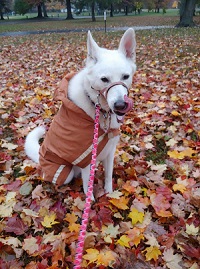 Ah, the lip lick! They can happen so fast! What a beautiful picture capturing this split second bit of canine communication from Tilly. The lip lick can be an attempt to self-soothe, thus an indicator that the dog is feeling stressed or uncomfortable about something that is happening. But it can also be an appeasement gesture or a signal of non-threat to whoever she's communicating to.
Ah, the lip lick! They can happen so fast! What a beautiful picture capturing this split second bit of canine communication from Tilly. The lip lick can be an attempt to self-soothe, thus an indicator that the dog is feeling stressed or uncomfortable about something that is happening. But it can also be an appeasement gesture or a signal of non-threat to whoever she's communicating to.
So, in this still, while we can see the communication, we may not be sure of the cause without knowing Tilly. The best indicator of the source of the lip lick is knowing what in the environment has just changed. Also the orientation of the eyes can be a clue. In this picture, she's looking directly at the camera, so might it be that she's uncomfortable with the camera eye upon her?
As Tilly's mom, I know exactly what's bothering her! She hates wearing the raincoat for starters. Stress is additive, so she is already starting with a baseline of discomfort having the clothes on. Add to that that she hates having her picture taken and we see the effects of her discomfort and her attempt to self-soothe.
Gotta love the richness of dog body language!
Creative Exercise... 13 November 2018
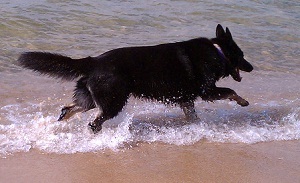 Exercise and mental stimu-lation are essential parts of every dog's day. While walks, romps in the yard, and play with other dogs are all examples of physical outlets for our dogs, this is by no means an exhaustive, or even creative, list.
Exercise and mental stimu-lation are essential parts of every dog's day. While walks, romps in the yard, and play with other dogs are all examples of physical outlets for our dogs, this is by no means an exhaustive, or even creative, list.
This is Trista herding waves. Doesn't she look like she's having a blast?! Swims at a beach or hikes on a wooded trail, running alongside a handler as they run or bike -- all of these activities add variety and novelty to a dog's exercise routine. (As with any athlete, you must build stamina gradually.) For the more serious competitors among us, dog sports like agility, adventure coursing, dock diving, disc, herding, weight pulling, freestyle, Treibball and so many others, are fun activities for dog and handler alike. And tapping into your dog's natural aptitudes, especially her breed-specific tendencies, can give a natural outlet to what can be otherwise annoying, challenging behaviors in the house.
Are you looking for some creative ways to exercise your dog? Check out WoofGang's list of canine sports!
Fear-Free... 12 November 2018
A lot of pets are scared at the vet, my dog Tilly included. Her puppyhood in the shelter involved frequent vet checks for nagging health issues, so she does not have a good impression of vet visits. She is frozen stiff with fear during a checkup. A lot of people, vets among them, think that this is fine, as all the work that needs doing can get done. But a dog frozen in fear is still a fearful dog. We need to do our best to make these experiences at the vet's office less scary and, dare I say, even enjoyable! After all, vet visits will only increase as your pet ages so we need to plan ahead for this eventuality.
Start by making "happy" visits, a visit where the dog does not get any medical care but simply learns that the clinic environment is a happy one, rich with treats and friendly people. This is Tilly in the waiting room of our vet's office on today's happy visit. On our first happy visit, she was too upset to even eat her favorite treat -- liverwurst! But thanks to a quiet waiting room, a supportive vet staff and a little love from her favorite vet tech Savannah, a trembling Tilly was at least able to lie quietly for the duration of the visit. With each successive happy visit, Tilly has gotten more and more comfortable so that, in this picture taken today, she could come and go and move around the waiting room, and lie quietly on the floor without trembling, hungrily eating treats. She was still hyperalert but she was also quiet and calm.
There are many skills we can train and techniques we can use that will help our pets cope better with the veterinary environment. This is the tenet behind fear-free training. And WoofGang's Laura Garber, as a Fear-Free Certified Professional (FFCP) Trainer, can help!
Using a Muzzle... 9 November 2018
Muzzles can be a great tool for a dog who triggers very quickly or has an unpredictable trigger and who pulls knives rather than well chosen words. Just as humans can deal with anger differently, and some resort to force far too quickly, dogs can do the same thing. So while you're teaching a dog more peaceful and appropriate responses when handling the unwanted or the unexpected, the muzzle is a wonderful safety device. And dogs can be perfectly happy wearing a muzzle if it has been associated with good things. For instance, greyhounds LOVE their muzzles as they associate them with racing.
If you think a muzzle might be a good option for your dog, use a basket muzzle like the Baskerville muzzle for anything longer than a few minutes (pictured here). A dog can pant, eat and drink with this muzzle on, unlike the nylon grooming muzzle, which is only appropriate for short duration use.
Playing Tug... 5 November 2018
Contrary to popular belief, playing tug with dogs does NOT cause aggression. In fact, as it mimics a cooperative kill in the predation sequence, tug can be a very bonding activity in which to engage with your dog. The training industry has moved away from even calling the game "tug of war" for precisely this reason, because it is not a conflict but rather a cooperation between individuals.
However, as with any activity that ramps up a dog's arousal level, if not practiced properly, it can be dangerous with a dog whose arousal reaches a high level of intensity. Dogs express arousal differently. Jumping, mouthing, humping, barking -- these are all behaviors that can occur when a dog is in an aroused state. If you play for so long that your dog becomes overly aroused and starts to engage in these behaviors, then it is too late; he has popped the cork, so to speak, on his arousal. And different dogs pop their cork with different amounts of play. While some dogs may get over-aroused with just a few seconds of play, others may never lose control of themselves. So the trick is to discover where your dog's threshold is and stay within it, then interleaving play with calm behaviors like sit or down. In so doing, your dog is learning how to keep himself "corked" and never lose control of himself.
So, if you have been avoiding playing tug with your dog, you are denying yourself and him a very valuable bonding activity. Just learn how to do it right!
Doggie Lifestyles... 29 October 2018

 Training is not a one-size-fits-all endeavor. The important thing about training is that it satisfies the lifestyle of the family and the needs of the dog. Tippy, the Yorkie, is not as highly trained as Tilly -- while she is trained to sit nicely in her stroller, she would be uncomfortable and fidgety if she had to lie quietly on the floor like Tilly is doing. But both have been trained in their own manner so that they can accompany their families to dog-friendly restaurants, an important aspect of the lifestyles of these two families.
Training is not a one-size-fits-all endeavor. The important thing about training is that it satisfies the lifestyle of the family and the needs of the dog. Tippy, the Yorkie, is not as highly trained as Tilly -- while she is trained to sit nicely in her stroller, she would be uncomfortable and fidgety if she had to lie quietly on the floor like Tilly is doing. But both have been trained in their own manner so that they can accompany their families to dog-friendly restaurants, an important aspect of the lifestyles of these two families.
There is one more consideration for a well-trained dog: that she also is a polite citizen in the eyes of the world at large. What might satisfy a permissive family might make others of the public put out or annoyed in a public setting. We should aspire for our dogs to charm even those who are not dog lovers. I want my dog to be better behaved than an honor student, a true doggie ambassador!
Would you like to have a cafe buddy? Or perhaps be more polite greeting visitors at the door? Training truly is the language that binds!
Loose-Leash Walking... 26 October 2018
Loose-leash walking is one of the most difficult skills to train a dog because it's so difficult to be consistent. The leash should be merely an emergency device, to keep a dog from running out on the street, for instance, but it should not be the device that keeps a dog walking by your side; instead your dog should WANT to walk at your side. The leash is also a telephone wire between dog and handler. When a dog is pulling, there can be no nuanced communication through the leash; it is just tight. With a loose leash, both dog and handler can feel its minute changes in weight and its movement between them, perhaps signaling a change in direction or in rate.
Consider loose-leash walking to be holding hands with your dog, and imagine how satisfying that would be!
BFFFs (Best Feline Friends Furever)... 19 October 2018
While Steffi and Django are the best of feline friends -- and it was wonderful getting two kittens at the same time so that they could develop this kind of relationship with each other -- it is not without its complexities. Django, a big tabby, is much more playful than his little sister Steffi, and he can be quite a rough player, overwhelming her with his size. That makes it all the more important that Django gets plenty of exercise and interactive play with his humans so that he is not constantly badgering his little sister.
As a kitty parent, it is important to evaluate and respond to each cat's needs so that peace springs eternal!
Body Language... 18 October 2018
 As important as it is to remember that dogs are dogs and not little furry people, I am still struck with how much we have in common, even in body language. Look at how universal the smile is! This is Porter, and you can't help but return his open-mouthed, goofy smile when he looks at you like this. And what about those eyes -- windows to their souls and to ours! I see a world of thoughts and feelings in Porter's soulful eyes.
As important as it is to remember that dogs are dogs and not little furry people, I am still struck with how much we have in common, even in body language. Look at how universal the smile is! This is Porter, and you can't help but return his open-mouthed, goofy smile when he looks at you like this. And what about those eyes -- windows to their souls and to ours! I see a world of thoughts and feelings in Porter's soulful eyes.
Delving a little further, dogs don't like to be hugged while humans do, BUT even humans don't want to be hugged by strangers on the street, right? That is an act reserved only for our closest friends. Dogs will often tolerate more from their family members than they will from others, and that is just like us humans. A dog might let a family member hug or kiss him, or wipe his feet dry, or give him direct eye contact, but he may find these very same things unpleasant, even threatening. coming from people he doesn't know. Dogs can be sensitive to looming or to being petted over the top of the head, or to being grabbed by the collar by strangers, but WE ARE, TOO! We can be very sensitive to unspoken personal space boundaries or to being touched without invitation.
What this all means is that we expect far more from our dogs than we do from ourselves. We expect them to tolerate infringements on their personal space and autonomy that we would never tolerate ourselves.
So let's take a lesson from Porter: WAG MORE, BARK LESS! And SMILE! Yes, he says, I'm talking to you!
Kitty Chess... 12 October 2018


It is interesting to watch the time sharing of space throughout the day. The current pattern is for Django to start on the dog bed early in the day and somehow over time Steffi ends up there later in the afternoon. This was not a direct replacement... what I mean is that the cats had moved around the house, had gone to get food or to follow me around the house, over the course of the day. But Django claims the dog bed in the late morning and it becomes Steffi's by later in the afternoon.
It is not unusual for cats to have routines like this, almost like reservations for sleeping spots throughout the day. So watch your kitties' chess game of resting spots over the course of a day!
The Soul of The Dog... 11 October 2018
 A picture is worth a thousand words and a face tells a lifetime of stories. One can plainly see the lifetime of stories on this beautiful dog's face, and many of them not good stories. Yet, this dog Abilene is arguably the sweetest soul to walk the earth. How can a dog be victim to a gruesome past and still retain a loving spirit and forgiving nature? That is the soul of The Dog. And we, as their partners and parents, owe them not only care and love and shelter but also education and training so they can live the lives they most desire -- to live beside us as partner, companion, and family member. And we must understand their communications and needs and must teach them our communications and expectations so that we can live in harmony. Let's help all of our dogs find the love, balance and harmony that Abilene has found in her life!
A picture is worth a thousand words and a face tells a lifetime of stories. One can plainly see the lifetime of stories on this beautiful dog's face, and many of them not good stories. Yet, this dog Abilene is arguably the sweetest soul to walk the earth. How can a dog be victim to a gruesome past and still retain a loving spirit and forgiving nature? That is the soul of The Dog. And we, as their partners and parents, owe them not only care and love and shelter but also education and training so they can live the lives they most desire -- to live beside us as partner, companion, and family member. And we must understand their communications and needs and must teach them our communications and expectations so that we can live in harmony. Let's help all of our dogs find the love, balance and harmony that Abilene has found in her life!
The Look of Love... 8 October 2018
These two pictures are striking to me, first because of the similarities. Both look pensive and self-contained, in their thoughts it would seem. Neither is communicating any social cues, like an open, lolling mouth or a tail held aloft, an invitation for interaction.
 But the differences, to me, are more striking. Bentley, the white mixed breed, looks listless, almost hopeless. There is worry in his brow and his eye ridges. Bentley is a shelter dog, and he has been for a long time... in this picture, he is in the
But the differences, to me, are more striking. Bentley, the white mixed breed, looks listless, almost hopeless. There is worry in his brow and his eye ridges. Bentley is a shelter dog, and he has been for a long time... in this picture, he is in the
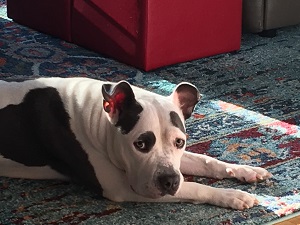 office where he is fostered. While he has had very committed staff and volunteers to love him, that is not a home and not a family. And this is what it looks like. A dog listless and with worry, even at rest.
The black and white dog, a loved family member, though not overtly excited or happy in this picture, has a look of ease and peace within her thoughts.
office where he is fostered. While he has had very committed staff and volunteers to love him, that is not a home and not a family. And this is what it looks like. A dog listless and with worry, even at rest.
The black and white dog, a loved family member, though not overtly excited or happy in this picture, has a look of ease and peace within her thoughts.
This is the difference between having a family and not. This is the difference between an owned dog and a shelter dog.
Kitty Perches... 5 October 2018
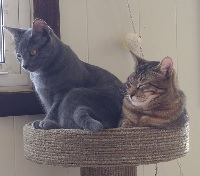 Hunters that they are, cats like having vertical space and perches from which to spy upon the world. In a multi-cat family it's important to have enough vertical space to satisfy everyone's needs. You can see that, in our household, Steffi and Django are content to share space a lot of the time, which is wonderful to watch, but everyone needs some alone time so there are a couple of cat trees and perches for them to choose from at any given time. In families where the cats are not quite as chummy, plentiful perches in various locations are crucial to keeping a happy household.
Hunters that they are, cats like having vertical space and perches from which to spy upon the world. In a multi-cat family it's important to have enough vertical space to satisfy everyone's needs. You can see that, in our household, Steffi and Django are content to share space a lot of the time, which is wonderful to watch, but everyone needs some alone time so there are a couple of cat trees and perches for them to choose from at any given time. In families where the cats are not quite as chummy, plentiful perches in various locations are crucial to keeping a happy household.
Sometimes All You Need is a Friend... 25 September 2018
My client Dante had an upsetting experience on the street one night, when a dog scared him by barking at him, and it made such an indelible mark that he was scared on his walk the following morning, despite the absence of anything eventful.
This is called one-trial learning, and it can happen when something extreme (from the dog's perspective) happens that really scares the bejesus out of him. The problem is that that event can be so terrifying that, in similar situations, the dog panics in anticipation of such an event happening again, even in the absence of a trigger... i.e. the situation itself becomes a trigger.
Fortunately Dante's mom sensed the importance of resolving this quickly because, the longer he anticipates walks as being scary, the more it becomes a self-fulfilling prophecy.
Tilly to the rescue! There's nothing better for a (dog-friendly) fearful dog than to have a role model in another dog, one who's confident. Dante and Tilly made fast friends and then they took a walk together and, sure enough, emboldened by his confident friend, Dante learned that there's nothing to fear but fear itself!
Final note: Understand that it's very important that care be taken for nothing extreme to happen on these first walks or it could amplify his fears. It can be helpful to have a professional help you with sensitive issues such as this.
Adopt, Don't Shop!... 24 September 2018
There are many reasons why animals find themselves homeless and in an animal shelter, and few of these reasons are the fault of the animal. Many families fall on hard times that can result in them having to move to a residence that does not allow animals, so an animal who has enjoyed many years as a loved family member may suddenly find himself in a shelter or rescue. Further, while animals are sometimes surrendered due to behavior problems, many of these problems are the result of not having been properly trained. For instance, though behaviors such as jumping up or mouthing may be cute and tolerable in a 4 month old puppy, they are far less so in a large, high-energy adolescent dog. Hence the reason that so many adolescent dogs find themselves suddenly in the shelter system, when just a little training could have avoided this outcome. House-soiling is another reason that a cat or dog might find himself without a loving home, but this can be one of the easiest behaviors to correct with just a little training, consistency and patience.
Any animal, whether from a shelter, a rescue, or a breeder, is going to require a settling in period when coming to his new home. He will need to bond to his new family and to learn how to communicate his needs to them and learn their needs and expectations of him. With informed adoption -- asking the right questions about any animal you're considering -- and preparation prior to bringing a pet home, then training and patience once you do bring him home, a shelter pet can become the friend that you'd always hoped for.
Nature vs. Nurture... 17 September 2018
A recent client of mine told me that another dog trainer had told her that her dog's (we'll call him Hugo) aggression was her own fault and that there was little hope of changing it successfully. Hearing this just broke my heart, for both the human and the dog! It's a wonder, after receiving such a dire, hopeless diagnostic opinion, that she continued her search for a solution for Hugo, but I'm grateful and inspired that she did. That is truly a committed dog parent -- she sought a better, happier life for her canine companion!
Behavior has both a genetic and learned component to it -- the age-old nature / nurture discussion. In this case, this client noticed aggression within days of bringing home her 10 week old puppy. That suggested to me that there was a strong genetic component to Hugo's behavior as there had only been 10 weeks of learning opportunities for this puppy, mostly from his mother and siblings... not enough to account for the severity of Hugo's behavior.
When working with behavior cases, it often doesn't matter why a dog behaves as he does because the techniques for working on the issue will be the same regardless. But when genetics are an underlying contributor to behavior issues, treatment is often facilitated by pharmaceutical intervention in combination with behavior modification protocols in order to balance the brain chemistry while simultaneously teaching new behavioral responses.
While Hugo and his human mom still have plenty of work to do on their road together towards healing and happiness, they have already made great gains, and even just a few easy changes had fast and powerful effect!
Social Maturity... 10 September 2018
Dogs reach social maturity somewhere between the ages of a year and a half and three, and maybe as late as four for some dogs. Behavior tends to start changing at around the 18 month mark and that change continues through this maturation period. So, a dog who was shy as a puppy often starts acting defensive aggressive at 18 months. A dog who, as a puppy, played with every dog and puppy she met will start to narrow her interests as she reaches this age, liking some dogs, ignoring others, and outright disliking still others. So, many changes and tendencies can start to surface at this time.
The problem is that, though the behavior starts to emerge at around 18 months, it will continue to develop over the course of this maturation period. That's why it is so important that, as soon as you notice behavior changing in your dog, you immediately set to work to modify it, because the behavior will continue to develop otherwise.
We know that old dogs can learn new tricks because, in fact, we adult humans do it every day! But we also know that a habit that is long practiced is harder to kick than a habit that has recently developed. So this is just one more reason for starting to modify concerning behaviors as soon as they begin to emerge.
The Dangers of Under-Socialization... 4 September 2018
All young animals experience a developmental stage during which they discover the things that are necessary to, and the things that threaten, their survival. For dogs, this sensitivity period lasts until somewhere between 13 and 16 weeks. The things they have not experienced during this time -- and the types of people they have not met -- will be things that, later in life, they will be cautious of or, worse, aggressive towards.
Dogs who are fearful of certain people, like men or children or someone with a limp, can be particularly troublesome because there are people everywhere! While a dog doesn't have to like everyone -- and frankly, how many of us like everyone we meet?! -- he does nonetheless need to be a polite canine citizen. This suggests a contract be made between us and our dogs: While we should be agent for our dogs, only permitting contact from those he likes and enjoys, our dog's contract to us should be that he will be polite and nonreactive.
(Read the complete article.)
The Doggie Daycare Debate... 27 August 2018
We all want to provide our dogs with the best -- with social outlets, with exercise, with company during the workday, preferably with as little of our own participation as possible. So, for many of us, with jobs that take us out of the home during the day, we look for solutions like doggie day care to provide these things for our canine companions. But the problem is that, as dogs approach social maturity, between the ages of a year and a half and three, their preferences and interests in other dogs change.
While puppies are often open and interested in playing with everyone, as they mature, their interests start to narrow -- an adult dog may be interested in some dog players but not others, or even downright dislike others. Most adult dogs prefer deep, close relationships with particular other dogs rather than the free-for-all of a pack of unknown dogs. This means doggie daycares and dog parks are not the right solution for most dogs.
But then what to do for our latchkey dogs? There are so many ways to enrich the lives of our dogs in healthy ways! Training, dog sports, walks and hikes to different places, outings with the family to dog-friendly places (obviously for polite canine citizens). Notice that these are all activities that will emphasize the bond between dog and human family members, the most important relationships that a family dog will have! Add to that play dates with their BFFs (best furry friends) for dog-friendly dogs and you will provide a rich, meaningful life for your dog!
Loose-Leash Walking... 22 August 2018
Loose-leash walking (LLW) is one of the most difficult skills to build because it requires consistency on the part of the handler. Allowing pulling on one walk, then insisting on no pulling on another walk will only confuse your dog and continue the habit of pulling.
One stop-gap measure you can try, since there are times when you just need to take your walk and can't take the extra time to insist on LLW, is to use two different pieces of walking equipment. For instance, allow pulling on the Easy Walk harness but insist on no-pulling with the Gentle Leader headcollar. Ultimately, as the LLW habit gains strength, decrease the walks on the EWH and increase the walks on the GL, until the habit is consistent and you can walk just on a collar!
Next step... loose-leash walking training ;)
Newly Adopted Dog... 21 August 2018
Dogs newly adopted from a shelter or rescue often have a little trouble with separation from their new parent. Further, often they don't love the crate and can be vocal when put in it. So they will need crate-training and separation training, because separation issues can turn into full-blown separation anxiety if not properly worked on.
Separation anxiety is over-diagnosed. It needs to be understood that separation anxiety is a clinical term for an anxious state similar to a panic attack in humans. Its symptoms can be vocalizing, breaking of housetraining in a housetrained dog, destruction and/or self-mutilation, escape behavior, anorexic behavior, and a panicked state (excessive saliva, panicked eyes...).
BUT it's important to correctly identify and diagnose the issue in order to resolve it successfully. A dog who chews things when his parents are absent could just be bored -- he needs more exercise before departure and then puzzle toys to give him mental stimulation. Vocalizing could be the same thing -- a dog with energy to burn and now his human playmate is gone, leaving him with nothing to entertain himself. Or it could be that outside noise is disturbing his rest. Breaking of housetraining could be that your dog is really not fully housetrained or that he was left for longer than he's physically able to hold it.
So correct diagnosis of the issue(s) and then working thoroughly, patiently, and consistently will be essential to your new family member's happiness. Consult WoofGang handouts for more help on these topics.
The Doggie Ballet... 18 August 2018
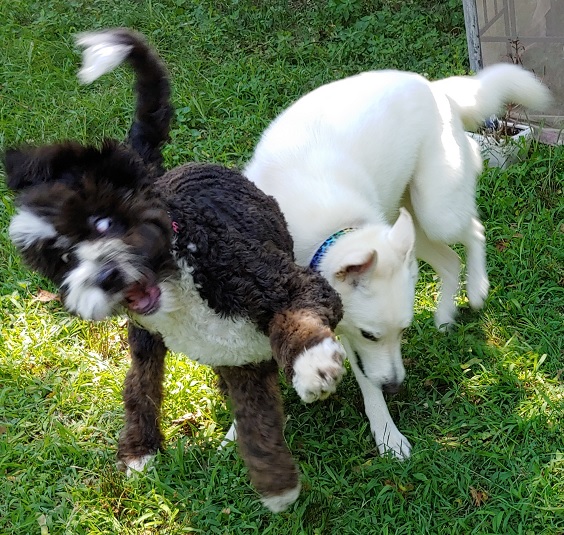 Healthy dog play is truly a ballet, complete with curtsies and leaps and do-si-dos! Another element of beautiful play is self-handicapping in the case of a larger dog to a smaller or an adult dog with a puppy, like playing from a down. Though biting, chasing, jump-ing, and humping are all elements of play, you can see that the quality of those things is soft and floppy and acrobatic. As play gets more serious, the roundness and verticality of movement is replaced by more horizontal, faster, harder and direct movement. That's a good time to stop things or it can escalate into a fight.
Healthy dog play is truly a ballet, complete with curtsies and leaps and do-si-dos! Another element of beautiful play is self-handicapping in the case of a larger dog to a smaller or an adult dog with a puppy, like playing from a down. Though biting, chasing, jump-ing, and humping are all elements of play, you can see that the quality of those things is soft and floppy and acrobatic. As play gets more serious, the roundness and verticality of movement is replaced by more horizontal, faster, harder and direct movement. That's a good time to stop things or it can escalate into a fight.
As parents to our dogs, it is up to us to monitor our dog's play style -- correct your dog's pushy, obnoxious play if the recipient cannot do it for himself, and remove your dog when she is the victim of such play from another. What I've noticed with Tilly's play is that she is a masterful player with most dogs, reading them beautifully and trying to deescalate their play if it's getting too rough for her, but she is prone to bully the shyer dogs. So, while I step in to help her when she is overwhelmed or outgunned, I correct her when she is the bully. That is dog parenting.
A New Puppy Sibling... 17 August 2018
The hardest thing about having a new puppy in the house was keeping him exercised so that he didn't drive the resident adult crazy. As great a sport as your older pooch may be, no doubt she enjoyed her naps and downtime without the puppy jumping on her head! That meant that, besides the hikes and walks you might take together, you and the puppy need to take some walks and do some training, just the two of youo. So it was extra work for the human parent!
Often people will bring a puppy into an adult dog household to keep their older dog active and interested. But the puppy must remain the responsibility of the humans in the household, not the older dog. Consider it like a teenager with a elementary school sibling. As much fun as the little one can be, every older kid needs some time to herself! So it's important that extra care be taken to keep the youngster well exercised and mentally stimulated.
Further, it's important that both dogs have opportunity to play with other dogs, with and without their "sibling" along. Too often, doggy housemates play only with each other and they lose the play skills that are more appropriate for a wider audience of playmates. Especially puppies will need plenty of play experiences with many different dogs so that they aren't only exposed to the idiosyncratic play styles of their older "sibling".
The long and short of it is that adding a puppy to the household takes more effort on the part of the humans, any way you slice it! But I'll also say that it was incredibly fun!!
Alpha?... 16 August 2018
The word "alpha" has become pervasive in our discussions about dog behavior so let's take a look at what that term means in dog behavior...
Dr. David Mech was the scientist whose studies in the 1970s described pack hierarchy and the alpha wolf. He has subsequently stated that these definitions of pack dynamics were inaccurate.
In wild wolf packs, relationships exist much like the human family, with the parents (breeding pair), older adolescent pups, and then the litter of babies. The older pups care for the babies and assist in the hunt to feed the family, much like a teenager performing babysitting duties and getting a summer job.
We would do a world of good for our canine family members if we looked upon them as requiring guidance from us as benevolent role models (read parents) and their relationships with each other as sibling children that need molding and direction in order to have healthy, respectful relationships with each other... because thinking that our dogs are alphas attempting world domination over us and each other is detrimental to all involved.
A New Puppy Sibling... 7 August 2018
Bringing a new puppy into the house is often more for the humans than it is for the dogs. An older dog cannot be expected to "care" for a young pup and keep her exercised and entertained. YOU have to do that, getting the puppy plenty tired out so that when she comes home, she's not mugging her old, stogie brother for attention all the time.
Further, you need to make sure that your pup is getting plenty of interactions with other dogs so that her play experiences are not only with her brother but that she learns how to interact with a world full of dogs.
So, before bringing home a new puppy, think long and hard about whether you have the time and energy to take on a new project. If you're animal family is happy just so, then you might not want to mess with it! And if you DON'T have a happy animal family, then there's some fixin' to do before introducing someone new to the mix.
Dogs and Kids... 11 July 2018
There are three kinds of dogs in the world, those who love kids, those who tolerate kids, and those who don't like kids. In a perfect world, we would want only dogs who love kids to be in children's households. Tolerance levels wane depending on many things: moods, stress, pain, tiredness, and so on.
Aggression is not an on/off, in dogs or in humans; it is a spectrum, from calm measured warnings, to hard eyed stares, to yelling, to punches, to knives, finally to guns. It is important to hear a dog's calm measured warnings of discomfort so that she is not forced to escalate her warning to something more like punches, or worse.
The problem is that, when dogs are afraid of children, the calm measured signals of discomfort may not be seen by young children. That can often mean that a dog needs to use more threatening behavior to get the message across. AND the dog will not feel safe or happy in her new home and the children will not have a dog who could be their canine bestie.
When adopting a dog, ask lots of questions, including how they are with strangers and new people, kids, dogs and other animals (like cats if you have them), around resources, with handling, and in play. Make sure that you pick a canine companion who matches your family and lifestyle.
Dog Play... 9 July 2018
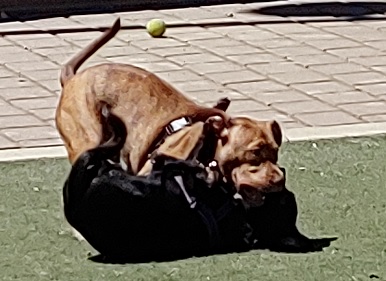
Is the little black dog having fun here? It can sometimes be hard to tell from a still photo, but the giveaway is the tucked tail and body curled inward. Play had started well with a game of chase, the little black dog as the chasee. He kept trying to use the rollover to decelerate the action until he was just overwhelmed and outdogged. He couldn't make the badgering stop.
Just because play starts out consensual doesn't mean that it remains that way. All too often, if the playmate is a bullish, disrespectful player, as the chasee tires, he may become a victim, and a fight can start as he tries to defend himself and back the other dog off.
As a doggie parent, you must be agent for your overwhelmed dog AND you should also be the magistrate for your bully player, stopping the interaction for both their sakes.
A Dialogue of Mutual Respect... 4 June 2018
Yesterday, at an outdoor pet-friendly event, I witnessed as a dog gave beautiful body language -- moving away, turning away, lip licking -- to say that she was scared and did not want to be petted by a child who was unfamiliar to her. Nonetheless, in an effort to "socialize" her, the dog's owner encouraged the child to pet the dog.
Two individuals were harmed in this interaction...
First, the dog was. Her choice had been to move away from a situation that made her uncomfortable rather than to move forward, potentially lunging or snapping, to drive the scary child away. But, rather than rewarding her choice, her signals were not respected and so she learned that offering nonaggressive warnings like this were ineffective. In the future, she may feel she needs to escalate her behavior in order to get her message across.
Then the little boy was. He had been tentative about approaching the dog, seeing her avoidance, but he was urged to by the dog's owner. So he learned that it was OK to approach a dog giving these signals which, in the future, may lead to a dog bite from a dog less apt to inhibit.
Such interactions should be dialogues between two consenting individuals. When approaching an unfamiliar dog, the dog's owner should be asked, who in turn asks the dog. Only good communication between dogs and humans will foster mutual respect.
Are There Really Two Sides to the Training Coin?... 26 September 2013
I had the distinct -- let's call it... opportunity -- to watch two dogs I care about getting leash corrected over and over again by another trainer while I had to stand by and hold my tongue. Afterwards, I was comforted by well-meaning people who said that it's just another training technique, a different opinion, the flip side of the same learning coin. But, well, I don't think so...
There was a time when punishment was an oft-used technique in children's education. My own father recalled how he was taught hand position on the piano with a rap of a ruler to the back of his knuckles, a technique I'm glad to say he never employed with me. Instead, he shaped my hands with his own so that I could feel what the right hand position felt like and experience it for myself. I learned to hold my hands the way he held his, high and rounded, like a delicate crane holding up the suspended fingers.
While taking a ruler to the knuckles or a belt to the tuckus was once an accepted "motivator" for educating children, today it is unacceptable, and very nearly grounds for a lawsuit, if a child is "educated" in this way. We've found other approaches where the same lessons can be learned pain-free. Only, really, is it the same? After all, though my father and I may have come out of the other end of those lessons with the same hand position, what learning happened internally for each of us? Did he develop the same level of trust in his relationship with his teachers, for instance, that I did? I would guess not.
So back to what I know a little about... dog training. A dog who jumps on people can certainly learn not to jump by 1. getting some well-earned treats for substituting alternative, more acceptable behaviors like sitting or 4-on-the-floor, or 2. getting a leash correction for every time his front feet leave the floor. To the casual onlooker, the result may look the same... a dog with four feet on the floor. But is his internal state the same? Has he developed a trust in his relationship with his leash-jerking trainer the same as he has with his "cookie-pushing" trainer? Again, I think not.
But I don't need to guess... he can tell his internal state, what he has learned about relating to humans, with body language. In her article Beyond Cesar Millan, trainer Janis Bradley beautifully and concisely describes the principle of learned helplessness, the complete suppression of behavior as a result of noncontingent punishment. A dog who has been trained in this way hunkers down, a body closed in on itself, unbehaving. And the message of his body language is in loud contrast to the confident, assured, alert dog's body who has learned to keep 4-on-the-floor through positive reinforcement. Inhibited behavior is not the same as changed behavior; it is unbehavior.
World-renowned trainer, behaviorist and author Jean Donaldson cites a long list of articles and interviews in which animal behavior professionals from across the industry refute the use of punishment-based training techniques in her article Talk Softly and Carry a Carrot or a Big Stick? But one thing she says is that our industry is divided into two camps, positive vs. balanced trainers, like Democrats vs. Republicans... two sides of the same coin. And with this I disagree. Because unlike politics, where issues can be addressed from equally valid and valuable perspectives, learning -- real, healthy, empowering learning, and for every organism -- happens when a teacher motivates, even inspires, a learner to behave and experience life in a new and better way, both externally and internally.
The Ins and Outs of Reinforcement... 29 August 2013
In my effort to emphasize the importance of the timing of the reward marker ("yes" or click) -- that it must happen exactly at the moment of the desired behavior, taking a picture of it for the dog -- I often say that you have "all the time in the world" to deliver the treat. The reason I say this is because there is the danger that, if you are urgent with your delivery of the treat, you may inadvertently delay your delivery of the reward marker, making you late in marking. But, for the sake of accuracy and perfecting training skills, I want to expound on this a bit. Because, to be honest, I lied. You really don't have all the time in the world, but you certainly have time enough!
So how have I stretched -- let's be kind and call it simplified -- the truth?
For starters, your dog needs to have learned that the reward marker (which a stuffy learning theorist would call a secondary reinforcer) portends the delivery of a treat (or some such primary reinforcer). Primary reinforcers are those things that the learner (or dog in this case) desires naturally -- food, play, walks, love, whatever. So the trainer first must lay the groundwork, or "charge up the clicker" or reward marker. And to charge up the secondary reinforcer, the treat needs to follow within two seconds.
This means I've instantaneously reinforced her, right? Well, yes and no. The virtual bacon is on her tongue, but secondary reinforcers lose their mojo if they're not intermittently reinforced == "yes!" is not bacon forever.
And even on the delivery, there was little sleight of logic... there is a difference between my standing in the same spot for a minute and then covering the 50 yards quickly in the next minute rather than my taking two minutes to slowly traverse the 50 yards. In the latter case, my approach is itself reinforcing. It is a bridge for my dog until I actually arrive with the treat. Alternatively, you could bridge standing still time with sweet banter about how lovely and smart a dog she is, also a reinforcer, and then cover the distance in a flash. But what probably wouldn't work (for long, at least) is to mark with a "yes!" and then continue talking to a neighbor for the next minute before traveling to her. A treat at that point is, well, pointless. Two minutes have passed and she probably has no idea what it's for.
So there's my confession. You have all the time in the world, if you use your time wisely.
Dominance Needs to Go the Way of the White Elephant... 21 December 2012
I think the word dominance should be removed from the vocabulary of every dog lover. It is not a word that has loving intent or promises a loving outcome. From my perspective, overcoming this word is an unending battle. It seems no one knows how to observe or communicate dog behavior without applying this attribute to it. In fact, the American Veterinary Society of Animal Behavior (AVSAB) has made a statement opposing the application of dominance theory in behavior modification in favor of the more positive approaches of reinforcing desirable behaviors.
The most damaging consequence of dominance theory is the application of punishment-based training techniques in order to make our dogs succumb to our dominance. There are inherent and often unavoidable difficulties to applying punishment in training, which I have discussed in my own writings (When Considering Using Punishment) but which are also thoroughly outlined in the AVSAB's position statement on the Adverse Effects of Punishment.
I know of more than a few dog guardians whose relationship has been deeply changed by employing alpha rolls and "dominance downs". And I find myself in very good company when I read of other behavior specialists, much more experienced, knowledgeable and famous than I, who relate stories about clients whose relationships with their dogs have been damaged by practicing punishment-based techniques. Dr. Sophia Yin, veterinary behaviorist, relates such stories in her article New Study Finds Popular "Alpha Dog" Training Techniques Can Cause More Harm Than Good.
So the science is behind me, as the preceding paragraphs attest. Ultimately dog training is just an application of learning theory, which works with every organism. But, instead of citing science, perhaps it's easier to draw on more personal contexts... How do you learn best? By encouragement or rebuke? By reinforcement or correction? Your dog wants to know.
Tails of the Leash-Reactive Dog... 7 September 2012
So I love this article. Firstly, I have a leash-reactive dog. Yes, I'm a dog trainer with a leash-reactive dog. You expected her to be perfect?!? Well, with work, Trista's become just about bulletproof but she still has her ugly moments. And no one understands it better than another guardian with a dog-reactive dog. I've dashed, hidden, cried, prayed to the gods, and everything else under the sun, just like this person. But what got me through the hard times was remembering that I am no more a perfect human than my dog is a perfect dog. She who casts the first stone...
There is a movement to put yellow ribbons on the leash of a dog who wants space. I like this idea, though I think it should be unnecessary. Why people insist on having their dogs greet every dog on the street when they clearly don't express the same social behavior with every human they pass on their walks is beyond me. All dogs should be granted their space unless both have that "come hither" look.
Not to be self-aggrandizing but... get a trainer! It doesn't have to be me! Just get any certified trainer who employs positive, relationship-building techniques to modify behavior. And don't wait til the last minute... til the month before your baby is due with your kid-phobic dog, or after you've already brought home a little canine sibling for your dog-aggressive pooch. Every day that your dog has to live with her fears is another uncomfortable day for her and an additional day that she practices the wrong behavior. As soon as you see an inkling of fear or defensiveness, pick up the phone. Nothing makes a dog trainer happier than helping bring peace to the multi-species family!
Anyway, the long and short of it is that it takes work, day in and day out... there's no magic fix. So many of my clients want a magic fix... HECK I wanted a magic fix! Instead, there will be good days and bad days. There will be countless times on the street when other ignorant owners let their dog get up in your dog's grill and scare the poop out of her. Just keep on keeping on. Love will find the way! Oh, and a healthy dose of laughter, fist-pumping, and bacon!
Territorial Behavior and the Mailman... 16 July 2012
Why does the mailman always get bitten?! Because his job is to come to the house, deliver the mail and go. So, as the dog looks out the window, he sees the mailman's approach and barks to alert the family. Then the mailman turns and goes, and Fido thinks that it was he who affected the departure. Now imagine all the passersby, people and dogs, passing the home with no intention of entering. Again, Fido attributes their continuing on their way to his barking. He starts to get an inflated sense of guarding the home. So, when people actually do come to visit and enter the home, Fido is forced to escalate his behavior in order to drive the interloper away, maybe by biting. And so territorial behavior is born!
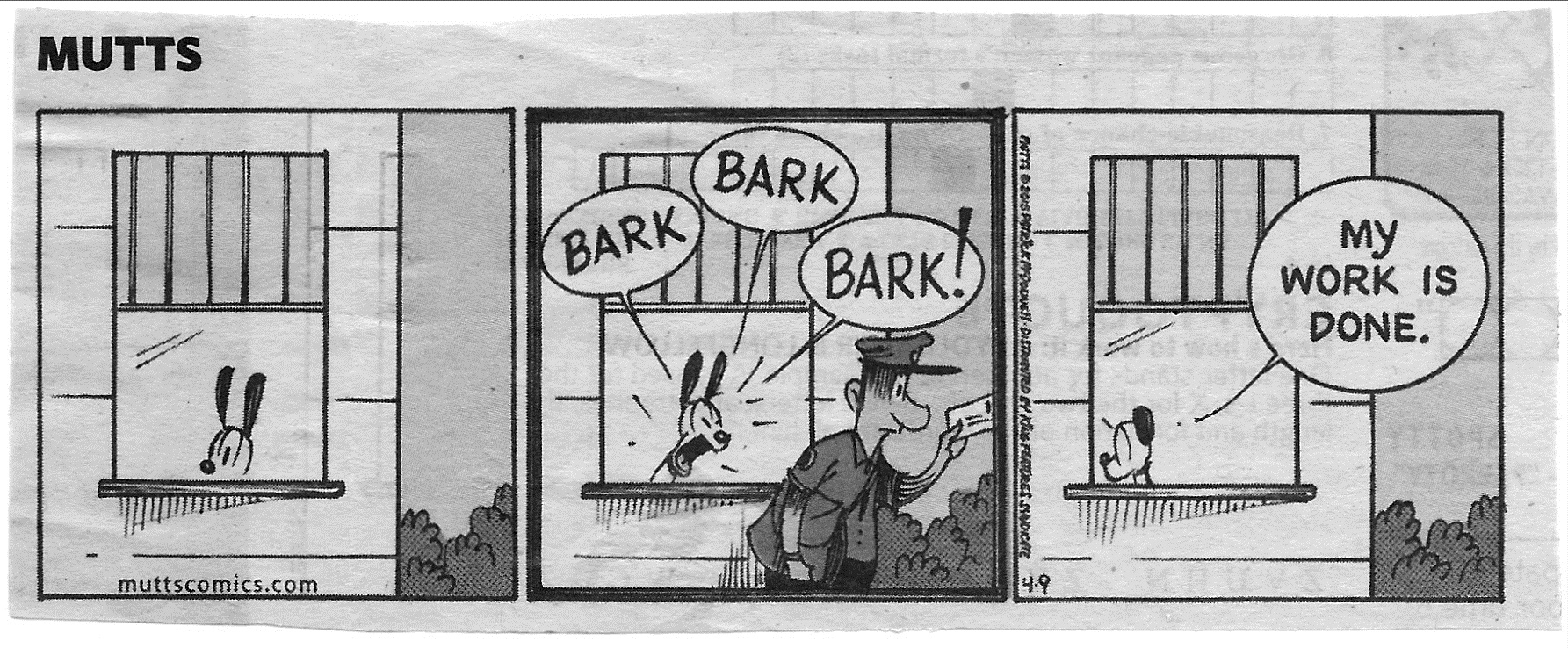
It is important that dogs who bark at passersby be prevented from performing the behavior when no one is at home. Otherwise they are practicing the behavior over and over again, perfecting it for the fateful day when someone dares to visit. So, when you're not at home, close the blinds, pull the couch away from the windows, use a decorative window film, or simply close your dog off from the room with the view. And, when you are at home, call him away with a touch and ask for another behavior, getting him to think about other things.
Impulse Control... 18 May 2012
Instilling impulse control means teaching your dog that he gets the things he wants for polite behavior, not for demanding behavior. If your dog wants to go for a walk, dancing around when he sees the leash is going to make the leash go back on the hook; sitting quietly to be leashed up is a successful way of saying please and will get the desired result. While waiting for his meal to be prepared, barking and whining will mean that the dinner bowl goes back on the shelf out of reach; sitting calmly and waiting to be released to his bowl will earn his meal.
Ideally, with impulse control exercises, you don't want to tell your pooch what to do explicitly. That would be solving his problem for him. Instead wait for polite behavior to be offered. This way your pooch is learning how to be a polite dog every moment of the day, not just the moments that he's receiving direct instruction from you.
Leash-Biting... 10 March 2012
Leash-biting is a dangerous game, often practiced by young adolescent dogs and especially by pit bull mixes. Tugging the leash or a rope toy harkens up prey drive, which terriers have in spades. The trick is to not get into a tug-of-war with them, at least when it comes to the leash. For dogs who get very aroused and dangerous, here are some tips:
- Use a firm "UH-UH!" right at the moment of grabbing for the leash and then copiously reinforce (verbally and with treats) when he drops the leash and offers an alternative behavior. Watch that a behavior pattern doesn't develop of his picking up the leash only to drop it, sit, and get a treat. Instead, keep the dog engaged with performing good behaviors (like loose-leash walking) so that this pattern doesn't take hold. It's just a question of breaking this bad habit and forging better ones.
- Letting the dog carry a toy may satisfy his oral needs.
- For the most aggregious offenders, try using two leashes and two handlers. When the dog grabs one leash, that handler can drop the leash and the other still holds a leash, and vice versa. The game may lose its allure.
Adolescents and Arousal... 4 March 2012
It's no mystery why so many shelter dogs fall into the category of medium- to large-breed adolescents. Adolescence is typically the age at which any species becomes rambunctious and unruly. In dogs, adolescence runs from 6 to 18 months, and the larger breeds have the potential to leave the greatest destruction in their wakes. It takes a patient, level-headed, and committed owner to weather the storm and guide their dog to realize their best self.
All adolescents need to be taught how to manage their own levels of arousal, and canine adolescents are no different. With extended amounts of play or excitement, a dog can become unruly and unmanageable -- jumping on you, crashing into you, barking at you, even becoming mouthy to the point of drawing blood. Instead of allowing your dog to remain at this fevered pitch, you must help him learn to manage his arousal levels.
To teach your dog how to better master his arousal levels, interleave play with control behaviors like sit or down before releasing him back to play. When playing fetch, as your dog returns with the ball, ask for a drop, then for a sit before throwing the ball and releasing him to retrieve it. In a game of tug, ask for a drop, then a down before releasing him to take the tug toy again. Over time, these games with rules will foster more respectful play habits.
Janis Bradley Comments on Cesar Millan... 11 January 2012
I love what Janis Bradley, author of Dogs Bite, says so much that I have to pass it on...
"On his TV show, the main method Millan uses for aggression is aversives (leash jerks, kicks, snaps of the hand against the neck, and restraint, among others) applied non contingently. The aversives are non contingent because they are so frequent that they're not connected to any particular behavior on the part of the dog -- the dog gets popped pretty much constantly.
This results in a state called learned helplessness, which means the animal hunkers down and tries to do as little as possible. This is what Millan calls "calm submission." It's exactly the same thing you see in a rat in a Skinner box that is subjected to intermittent shocks it can do nothing to avoid. This can happen quite fast, by the way, shall we say in ten minutes?
The dangers to the dog are obvious, ranging from chronic stress to exacerbating the aggression, i.e., some dogs fight back when attacked. This latter is the simplest reason that aversives are a bad idea in treating aggression. Even used technically correctly as positive punishment for specific behaviors like growling and snarling,
aversives do nothing to change the underlying fear or hostility, so the best you can hope for, in the words of famed vet and behaviorist, Ian Dunbar, is "removing the ticker from the time bomb." Thus such methods substantially increase the risk to humans of getting bitten."
What a beautifully scientific analysis of Cesar's "hocus pocus". See a recent article called Talk Softly and Carry a Carrot or a Big Stick? for more on this topic...
You're Being Watched!... 22 June 2011
One of the most striking differences between canis lupus and canis familiaris is the latter's ability to read our facial expressions. As dogs have evolved at the side of humans, they have been attentive students, learning to distinguish the ripple of expressions that pass over our faces with the same fluency that they read their own brethren. With this in mind, make sure not to give your dog mixed signals. If your pooch is doing an undesirable behavior, like jumping up or pawing at you, no matter how cute he might seem to you at that moment, don't smile while saying "no". This is like the old saying: "Your words may say no but the rest of you is saying yes, Yes, YES!" Try to send a consistent message on all frequencies: words, tone of voice, body language, and facial expression.
See a recent New York Times article for more on this topic...
NILIF -- A Training Buzz Word... 4 April 2011
The principle of NILIF ("Nothing In Life Is Free") is that your dog needs to work for everything he deems valuable. Under NILIF, nothing should be proffered for free. He needs to learn that you are the one granting him each and every resource -- food, toys, affection, access to furniture, going for walks, everything.
How strictly you adhere to NILIF depends on your dog. A dog who is pushy and demanding and disrespectful of others' space should have a more strict NILIF structure than a dog who is polite, respectful and compliant.
Some trainers insist on an unwavering "one-size-fits-all" approach to NILIF and, I'll admit, there are some dogs who would be unbearable without such complete compliance. But a majority of dogs and a majority of owners needn't obey such a strict lifestyle. Don't we live with our furry canine companions so that we can tousle their fur and rain kisses on their wet noses even when they're not sitting politely at our feet?! I'll admit wholeheartedly that I do!
More to the point, and of greater concern, is that if such a strict regimen is insisted upon, pooch parents are less likely to execute it consistently, and inconsistency is the devil's workshop. Dogs trained with inconsistent structure will be less certain of their lifescape and more likely to test boundaries and make mistakes.
So, while NILIF may be appropriate for the most challenging dogs, what's more important, and most achievable, is NGGFBB ("Nothing Good Granted For Bad Behavior"). Now that's a tenet I think we can all live with!
People Food as Treats -- To Do or Not To Do... 21 March 2011
So many of my clients worry that feeding their dog people food, and from their own plate no less, will encourage him to beg at the table at meal times and will cause him to turn his nose up at his own food.
I heartily disagree. It's not what treats you're feeding your dog and where you're feeding them to him that will teach him to beg; it's when you're feeding him! It might start with him putting his paw solicitously on your knee. You think it's cute and you give him a tasty tidbit. A soft paw in the lap becomes a more brusque pawing of your leg, then a shoveling of his head under your hand, and so on. Before you know it, you've got yourself a beggar.
Instead, if you teach your dog that calm, quiet, polite behavior gets appreciation and treats, then that is the behavior he will demonstrate. If he gets rich reward for lying quietly at your feet, then this is precisely what he'll do. Imagine how hard he'll work for such delightful delicacies as boiled chicken, cheese, hot dogs, even steak! And they are as healthy for him as they are for us.
Of course we don't want our dogs to reject their normal dog food in favor of people food. Canine diet, whether in dry kibble form, in canned form or in a raw or home-prepared diet, needs to be specially formulated for their complete nutritional needs. If your dog is rejecting his food, there may be more at issue than the human food he's getting as treats. Instead, he may not like his food and it would behoove you to find a more palatable (and healthy) alternative for him.
Gravitational Pull of a Distractor... 22 February 2011
Some dogs find it difficult to attend to their handlers in the company of dogs, people, or other distractions (like cats or birds). They are too transfixed by the distraction to listen to commands or tear their attention away. I call this the gravitational pull of that distractor. You need to keep a distance from the distractor where your gravitational pull is stronger than that of the distractor.
So, for instance, if there's a dog approaching you on the sidewalk, get Fido to a distance from the dog where he can still "hear" you and respond to your commands. Ask for a behavior, like a sit or down or watch or touch -- not always the same behavior or he will start doing it automatically and so he won't have to attend to you. Then, when he's obeyed the command, reinforce him, either by letting him meet the dog (if that was your intention) or giving him a treat and walking away.
With consistent training and practice, the gravitational pull will decrease and Fido will be able to attend to you at closer and closer distances from the distractor.
The Dangers of Too Much Freedom... 9 February 2011
People frequently complain about the issues that arise from a pup who has not yet learned proper house manners. Perhaps you're familiar with them... potty accidents in the house, chewing on shoes and pillows, jumping up on the furniture and counters. What this tells me is that the dog is being granted too much freedom without appropriate supervision.
My motto is: The more freedom a young dog gets now, the less he'll get in the future; the less he gets now, the more he'll get in the future.
Your young pooch is developing habit. Whether that habit will be chewing on the family heirlooms or chewing quietly on his toys is entirely up to you. If you decide to leave him to his own devices before he's developed the right habits and he develops a taste for wood furniture, then that will be a habit that'll need to be broken before you will feel compelled to leave him free in the house. Instead, if, in your absence, you keep him confined with only appropriate items available to him and then, when you are around, you supervise him closely to make sure he stays on the right path, then he will develop habits that you'll be able to trust for all the years that follow.
The choice is up to you. Don't make your dog suffer a lifetime of limitation for the sake of the short-term gratification you feel by giving him his freedom before he's ready!
Time-Outs... 3 February 2011
When your dog is practicing an undesirable behavior, like nipping at heels or being barky, mark with a no reward marker ("uh uh!"). If the behavior continues, then say "Too bad!", and grab your pup's leash and take him to a door, putting him on the other side of the door from you with the leash threaded through the door to your side. (Alternatively, you can tie the leash to a door handle and walk away from him, if that's easier. Or you can leave the room yourself, closing the door behind you, and only returning when he's quiet.) The time-out shouldn't be long, only 15 to 30 seconds, just long enough for your pooch to miss your companionship but not so long that he gets distracted with another activity. Let him back in and interact again; see if the behavior is being inhibited. If not, repeat the time-out. Do not let him back in if he's barking or otherwise complaining.
An important note: Make sure that, when putting your dog into the time-out, you do not touch him but instead just grab the leash to usher him away. Physical contact with the dog will be construed as reinforcement of the behavior.
The Dominance Myth and Misnomer... 2 November 2010
The term dominance has developed into a catch-all for characterizing just about every undesirable behavior our dogs practice -- from jumping on people in greeting to barking for attention and lunging at other dogs on the street. It has become our excuse for behavior that is really just that of a poorly trained dog.
This wrestling that we're doing with the question of dominance is perhaps the single greatest threat to our relationships with our dogs. And the things we do in the name of asserting our dominance mar the loving fabric we have woven together with them.
Because dominant behavior is so rarely the underlying cause of behavior problems, we should challenge ourselves to leave the word dominance out of our vocabulary entirely, and instead compel ourselves to identify the true root issues. Our relationships with our dogs would undoubtedly be the better for it.
Coppinger on Pack Behavior... 22 August 2010
"Pack behaviors, like all behavior, are epigenetic -- above the genes. They are a result of behaviors learned during the critical period. Pack behavior is just one of many social options available to wolves.
If dogs don't develop pack social behavior during their critical period, there is no sense in trying to simulate pack leadership after that social window closes.
Pack behaviors are much more complicated than just hierarchies of social status. They are learned through social play and care-soliciting behaviors during the juvenile period.
A trainer who pretends to be the alpha leader of a wolf pack -- say, by turning a dog over onto its back and getting down and growling at its throat -- is intimidating the dog, no doubt. But to a dog, the message is not what the trainer thinks it is.
Teaching and learning are seldom facilitated by intimidation. A dog doesn't learn how to sit from a trainer who intimidates it, simply because the coercion diverts the dog's attention away from the task and toward its social status.
An alpha wolf is not trying to teach a pack member anything, especially to sit. The fact that so many believe the wolf-pack homology, and use it in training a dog, is really a testament to how little is understood about canine behavioral development."
(by Ray and Lorna Coppinger in Dogs – A Startling New Understanding of Canine Origin, Behavior & Evolution, p. 110, Scribner 2001)
The Canine Tap-Out... 10 August 2010
Dogs sometimes roll over on their backs in an evasive maneuver, referred to as a "tap out", to avoid certain handling. The term "tap out" comes from wrestling jargon for the flat-handed tap a wrestler might do on the mat to signify he wants to quit the match. In dogs, though it may look like a request for a belly rub, it is really a form of passive resistance, or passive submission, given in response to something that is being done. The maneuver often happens when you'e trying to put on a leash or manipulate a collar, harness or head collar -- your dog is trying to turn off your collar-grabbing behavior, for instance. To persist may only drive him to escalate his protest because, from his perspective, his wishes are not being heard. As a result, he may protest with a growl or even a snap.
So, instead of insisting on continuing, help your dog gain more ease with what you're trying to do. If it's a concern about collar grabs, teach him "gotcha". If he consistently taps out when you're putting the harness or head collar on, teach him a "get dressed" exercise to have him put the equipment on himself. Read Laura's article on the Newark Examiner for more on these techniques.
Using the Environment to Your Advantage... 19 June 2010
Food is not the only agent of rewarding or reinforcing a behavior. When on a walk, often the surrounding environment is even more interesting than food. To a dog intent on moving things, nothing will be more rewarding than being allowed to chase a napkin being carried by the wind! If your pooch wants to greet a dog or sniff a tree, don't allow her to pull towards it; instead ask her to perform a behavior, like a sit, down, touch, shake, anything. Insist on the behavior. If she does it, then say, "OK, go [say hi/sniff/etc!]". If not, then "Too bad!", and turn away. You are the master of the environment and can grant or deny its access.
Remember: Don't always ask for the same behavior, like a sit, for instance. Then your pup will be able to simply tune you out and default to that position. Instead require her to really attend to you by making different requests each time.
Canine Flu in Hoboken... 7 June 2010
There have been several confirmed cases of dog flu reported in Hoboken. To be safe, avoid meeting other dogs for the next few weeks, either on the street or at dog parks. Keep an eye out for symptoms that are similar to kennel cough, runny nose with dis-charge, and high fever. At the first sign of symptoms in your dog, see the vet.
Toys are More Fun!... 5 June 2010
I remember fondly how, when I was a child, my father could make a forkful of broccoli or green beans a entertaining mouthful by transforming it into a plane coming in for a landing on my tongue-tarmac. What child hasn't fallen for this old chestnut of a parenting trick and enjoyed it despite themselves?!
Well, I've noticed it can work with dogs, too! I've seen more than a few dogs who, though not particularly turned on by their kibble, will suddenly eat with renewed vigor when their food is distributed in a puzzle like the Tricky Treat ball (by Omega Paw). My own dog will overlook nuggets of food strewn on the floor and opt instead to toil over her food-stuffed ball, though the food is exactly the same!
The trick is to spend time teaching the dog how to access the food from the toy first, employing particularly tasty treats to jump-start his motivation to work. Once your dog has mastered the toy and is enjoying the challenge, then you can stuff with less valuable tidbits, like his normal kibble.
Little Dogs Get No Respect!... 27 May 2010
I remember watching in sadness as a client of mine yanked and dragged his darling toy poodle from one place to another with no regard for the dog's autonomy or personal space. If this were the only time I'd seen such an injustice, then so be it, but I witness such things nearly daily. Just two nights ago I watched a kindly maltese be dragged hither and thither at Ralph's Italian Ice!
And so I've come by the axiom: All little dog owners should be required to own a big dog first. Except under the most dire of circumstances, such as when a dog wanders too close to traffic and needs to be pulled abruptly out of harm's way, no one would dream of manhandling a rottie or shepherd the way they might a little lhasa. We invite big dogs to join us, to follow us, to move with us. With little dogs, we force more than we invite.
Let's not marginalize our best friends, no matter how small they might be. If you find that you and your pooch are not like-minded in the ways you spend your time together, that you need to use your leash to keep your dog beside you, then training can teach your dog all of the reasons why being by your side should be his favorite thing!
The Use of Treats in Training... 20 May 2010
When employing positive training, we use treats to reinforce, or reward, a target behavior. My clients often wonder how long they will have to keep giving treats -- will they be committed to giving treats forever?! The answer is emphatically NO! Treats are an incentive for the dog to learn a challenging, new behavior. Once the behavior has been established, you reinforce intermittently, sometimes rewarding, sometimes not. Over time, the act of performing the behavior itself becomes reinforcing because of its happy history. So, for example, when we teach a dog to sit and give him a treat for doing so, we are utilizing consequential learning -- being reinforced as a consequence to performing a behavior. However, over time, the act of offering a sit itself becomes reinforcing because of the happy history attached to it. This is why training is so beneficial: a dog not only learns to be a well-behaved family member but also learns to enjoy being a well-behaved family member!




